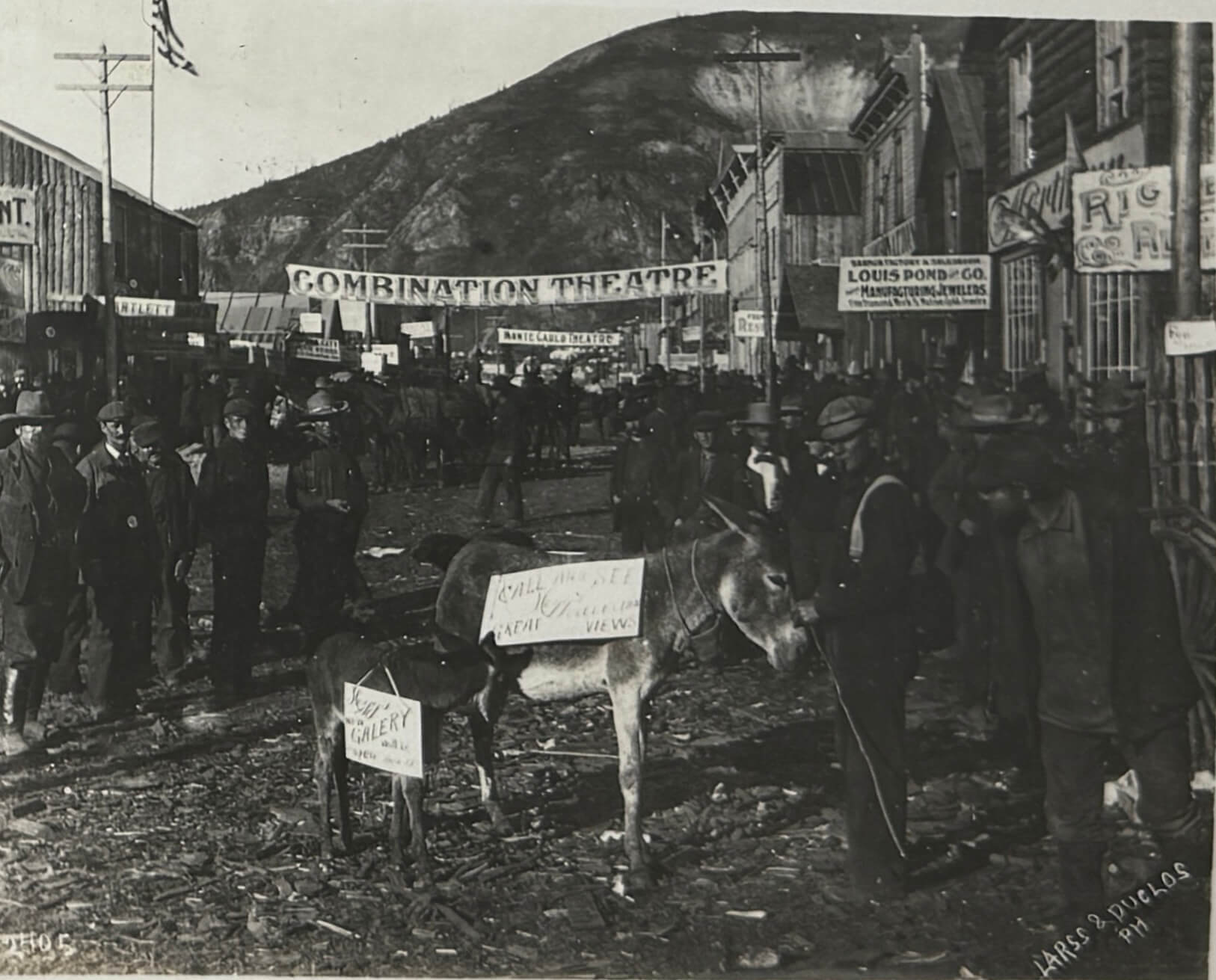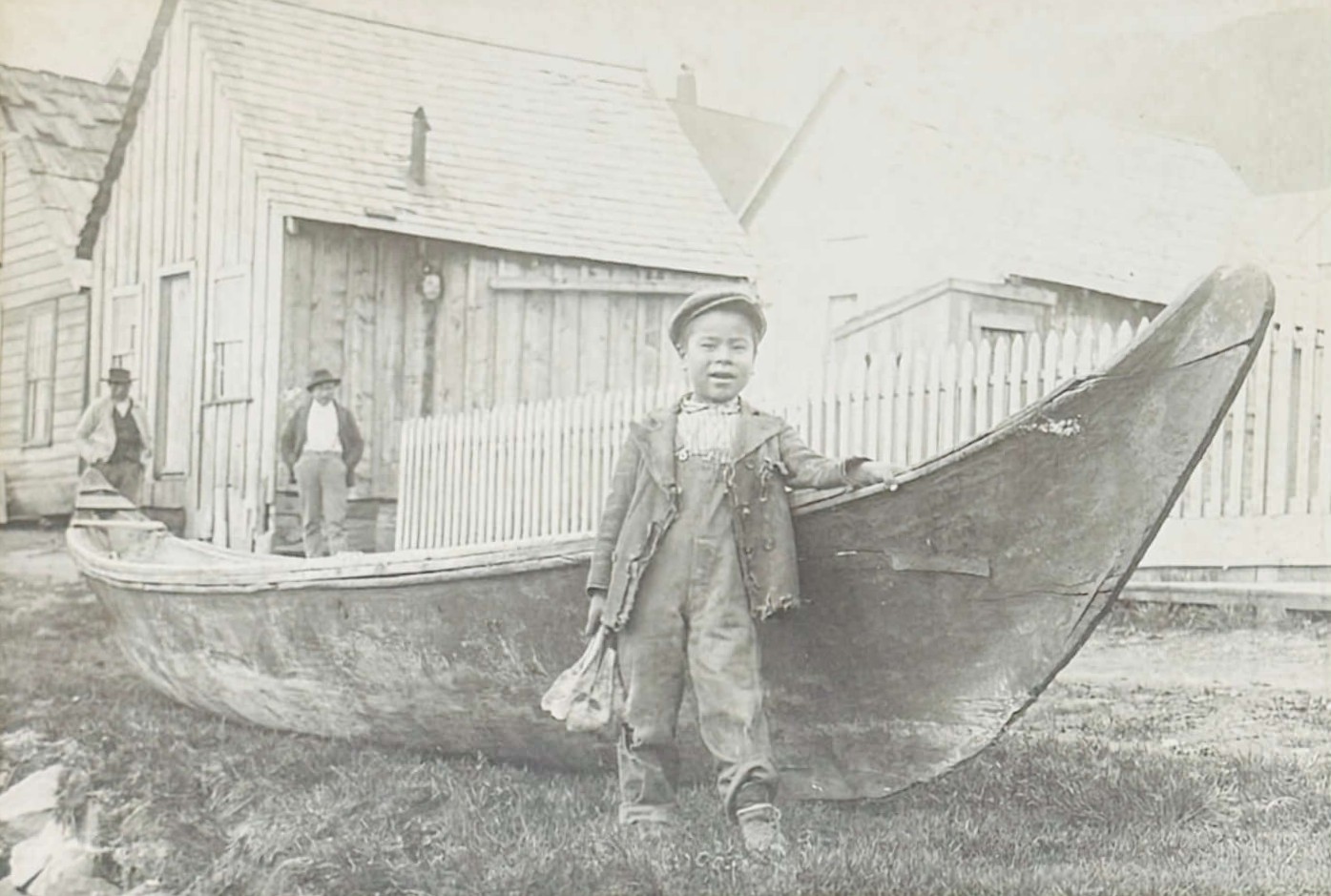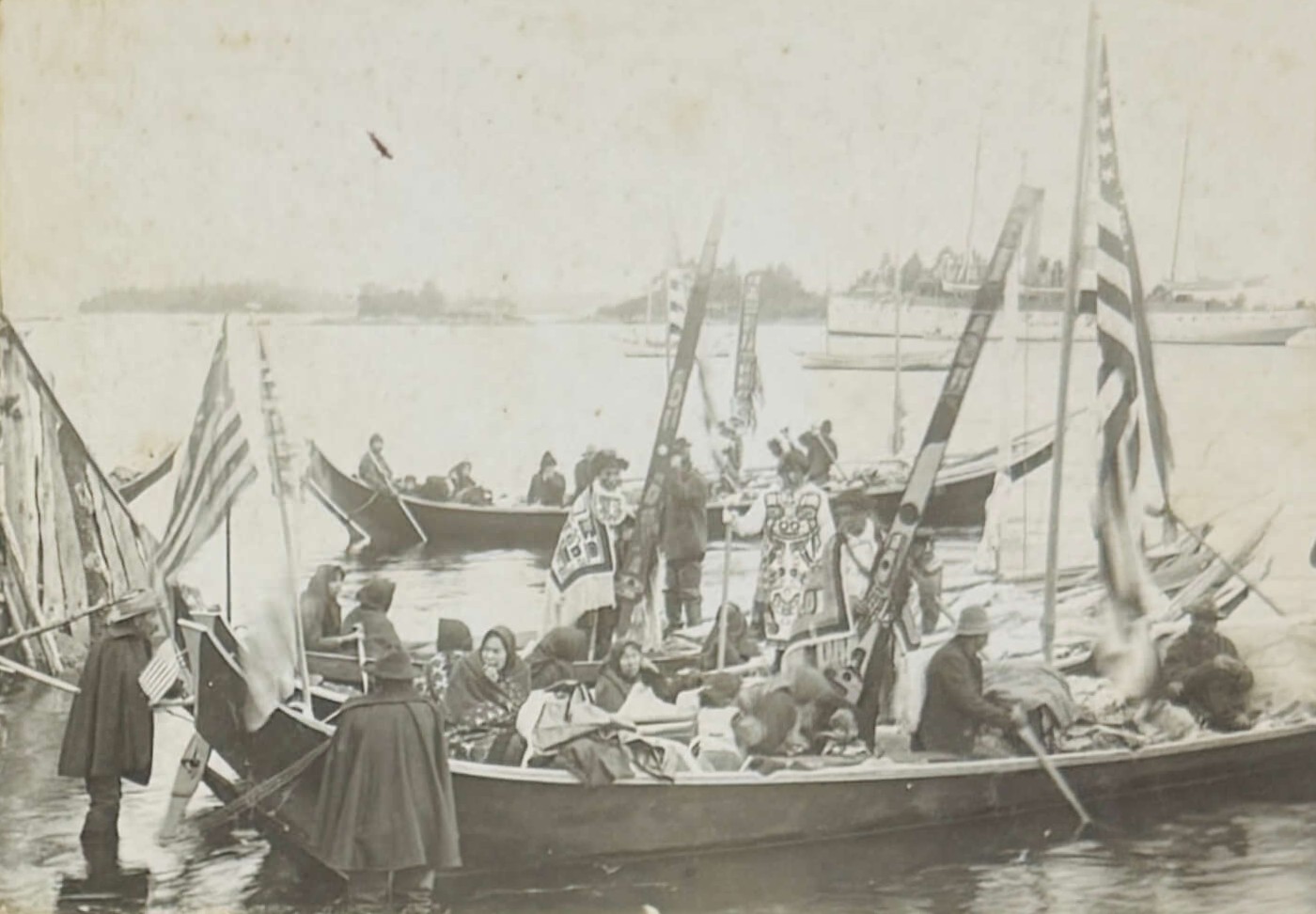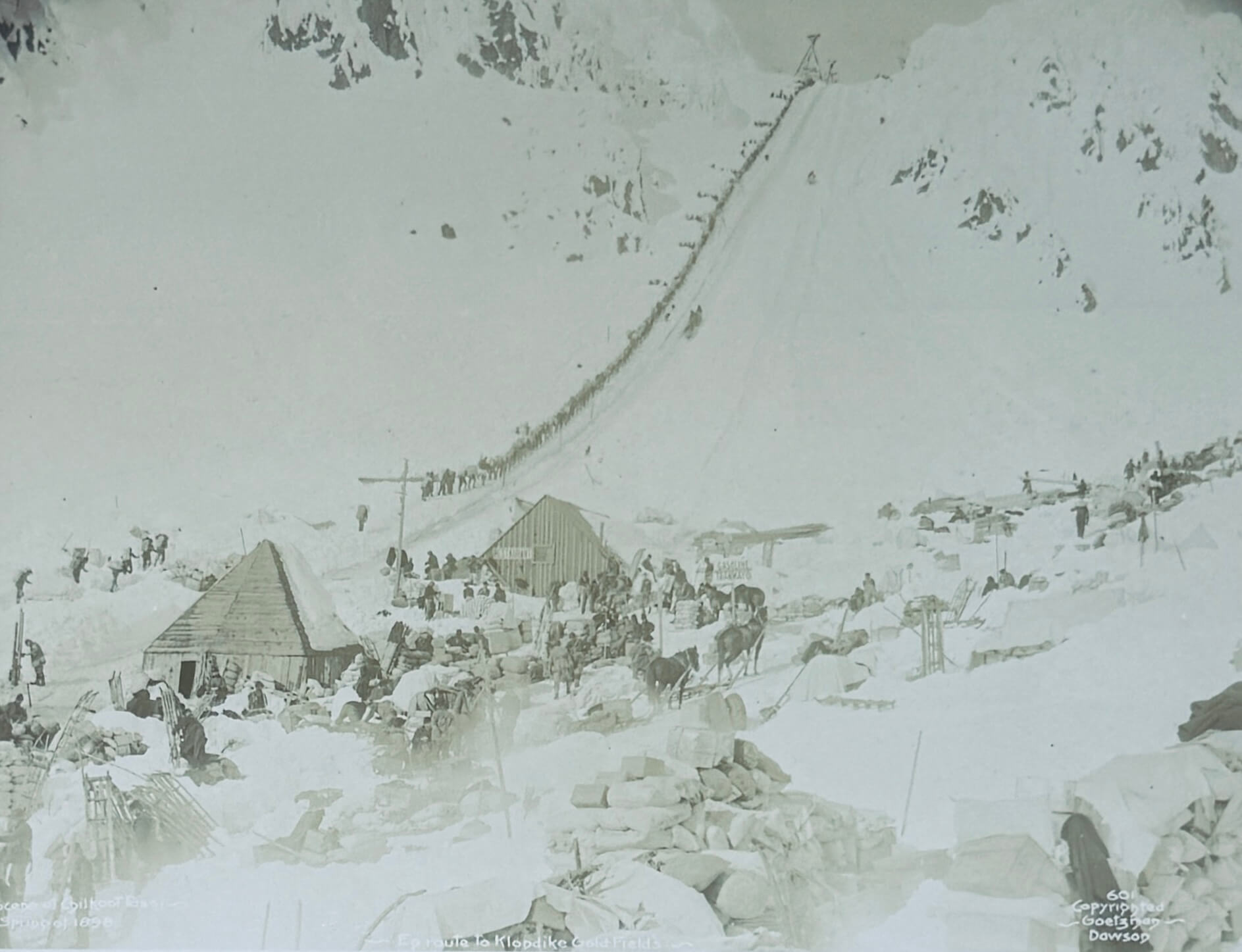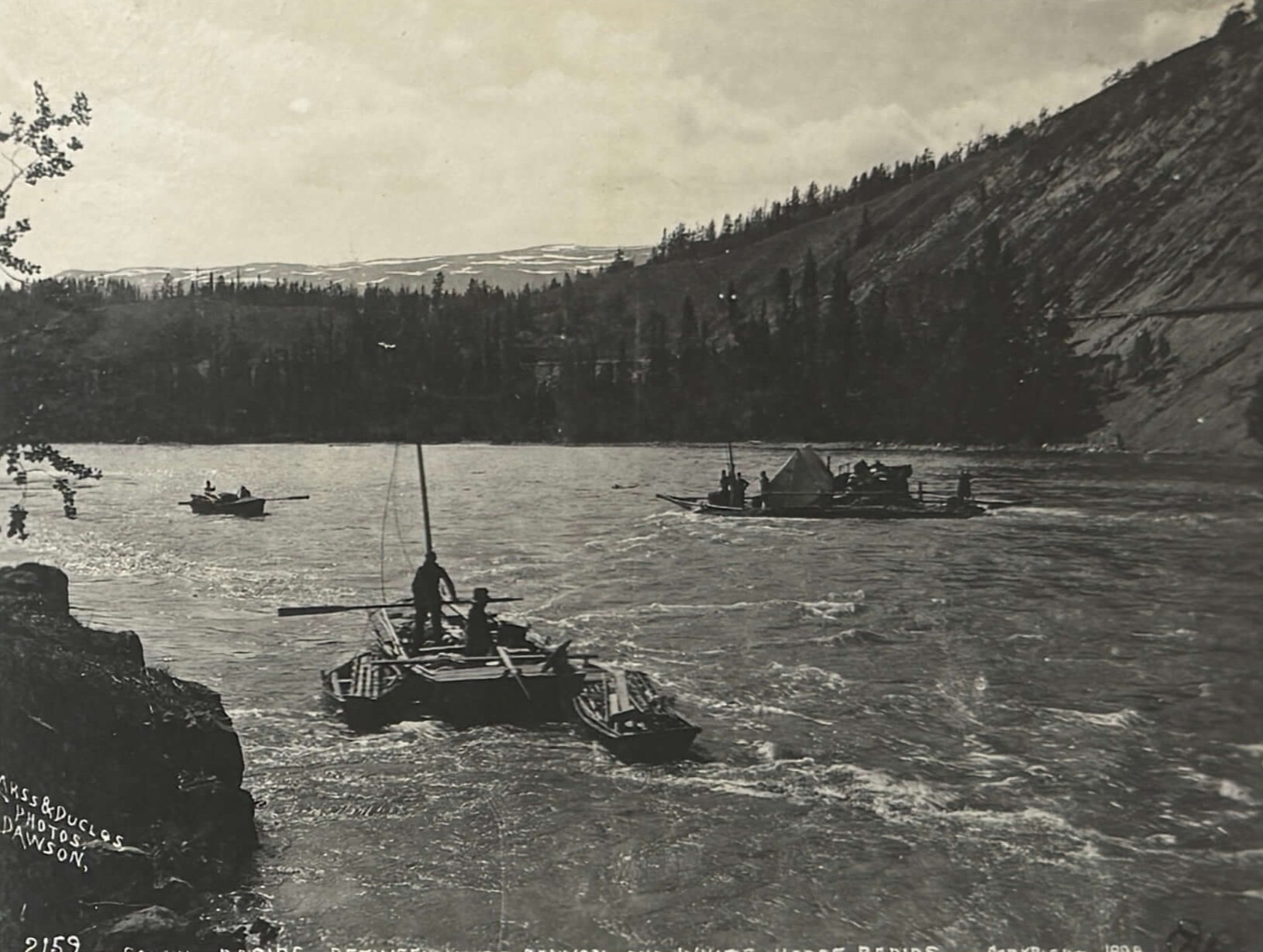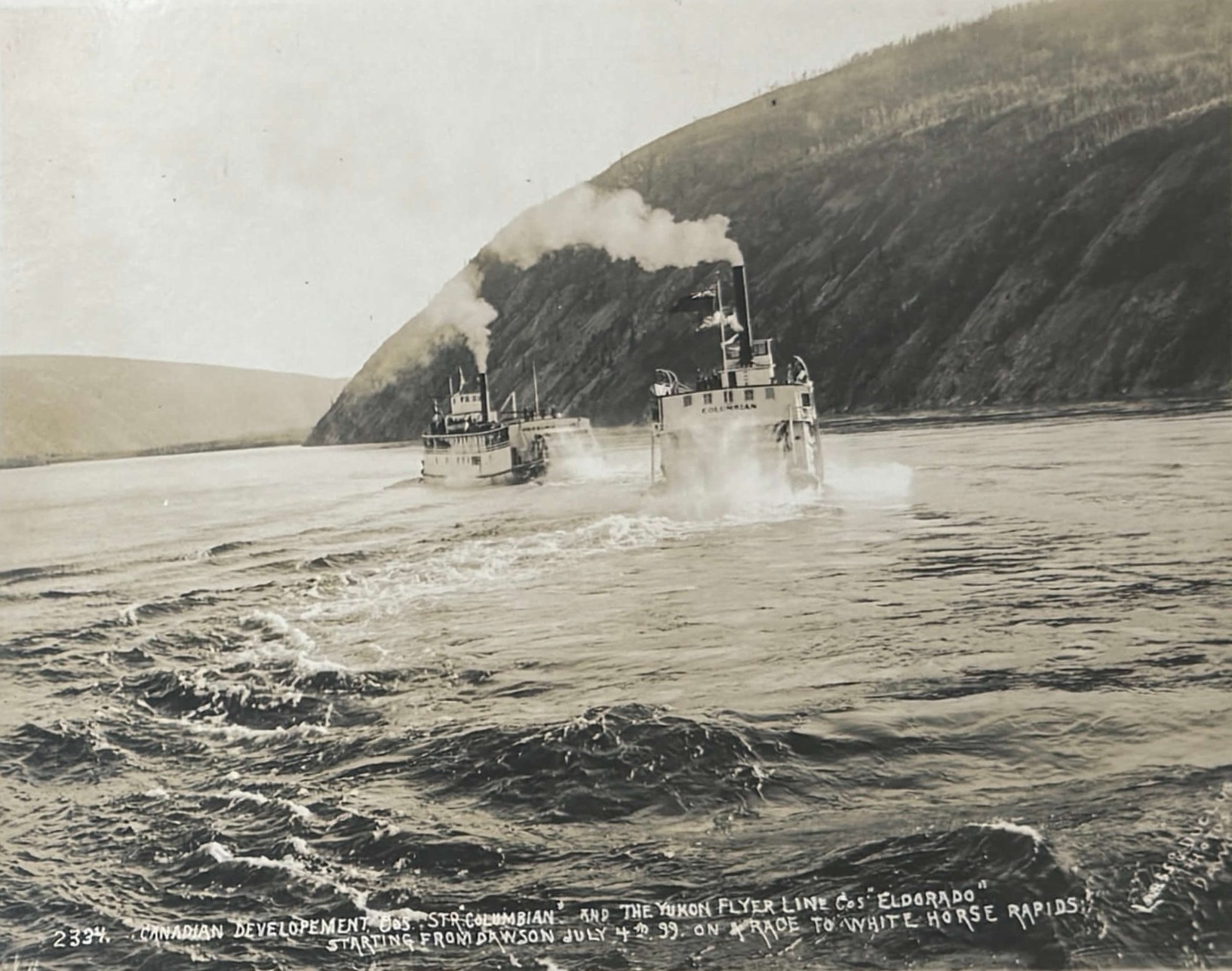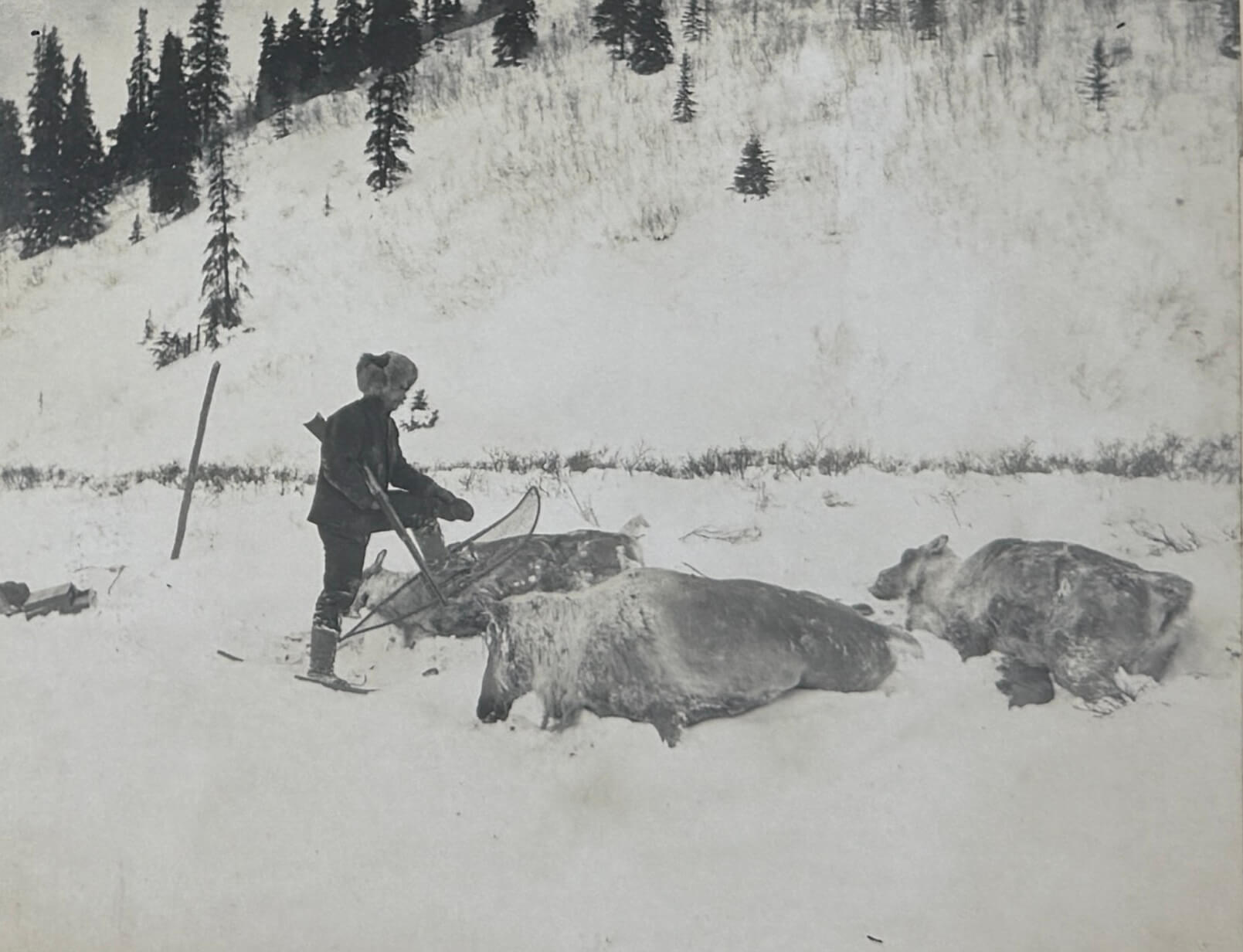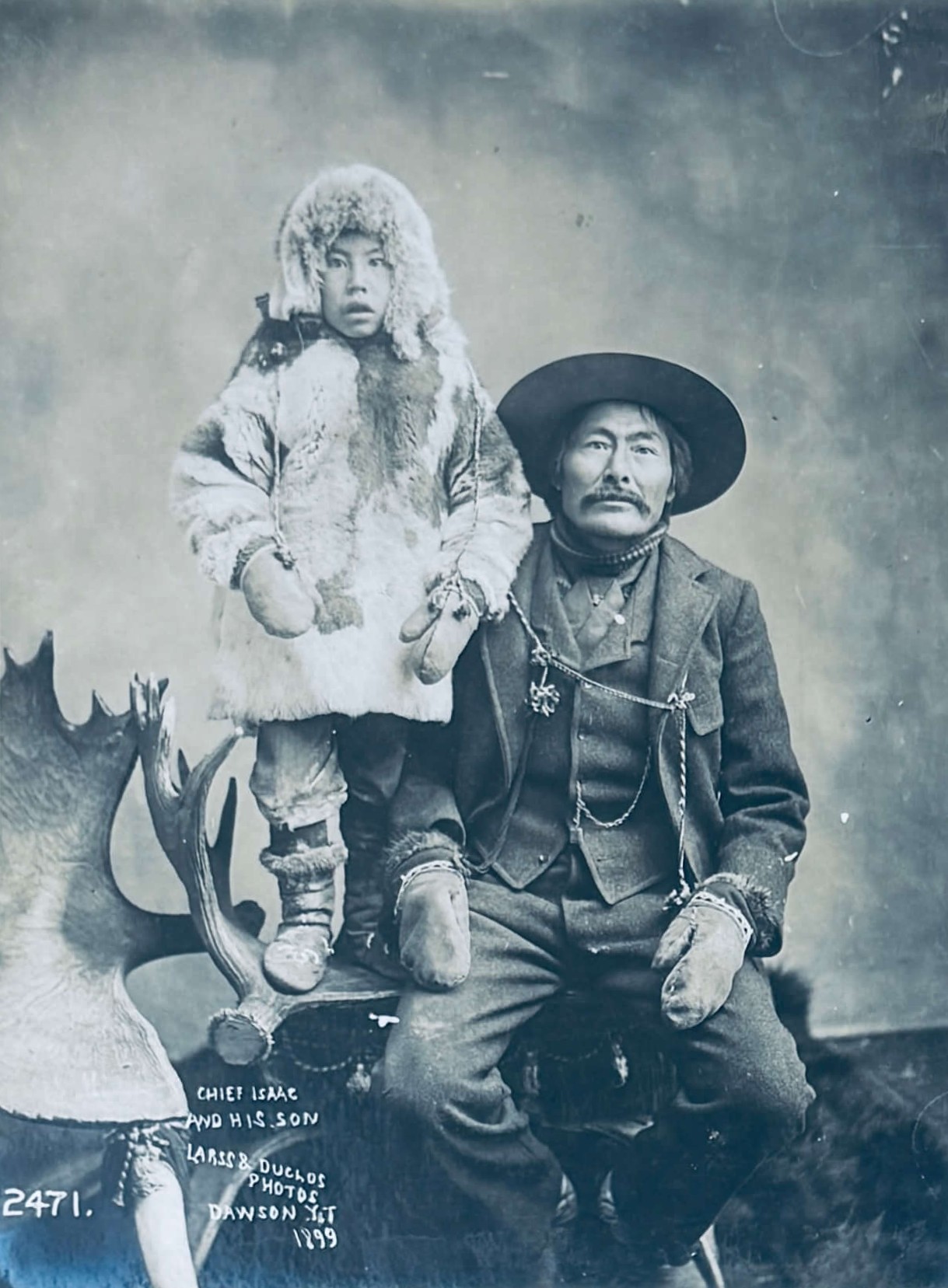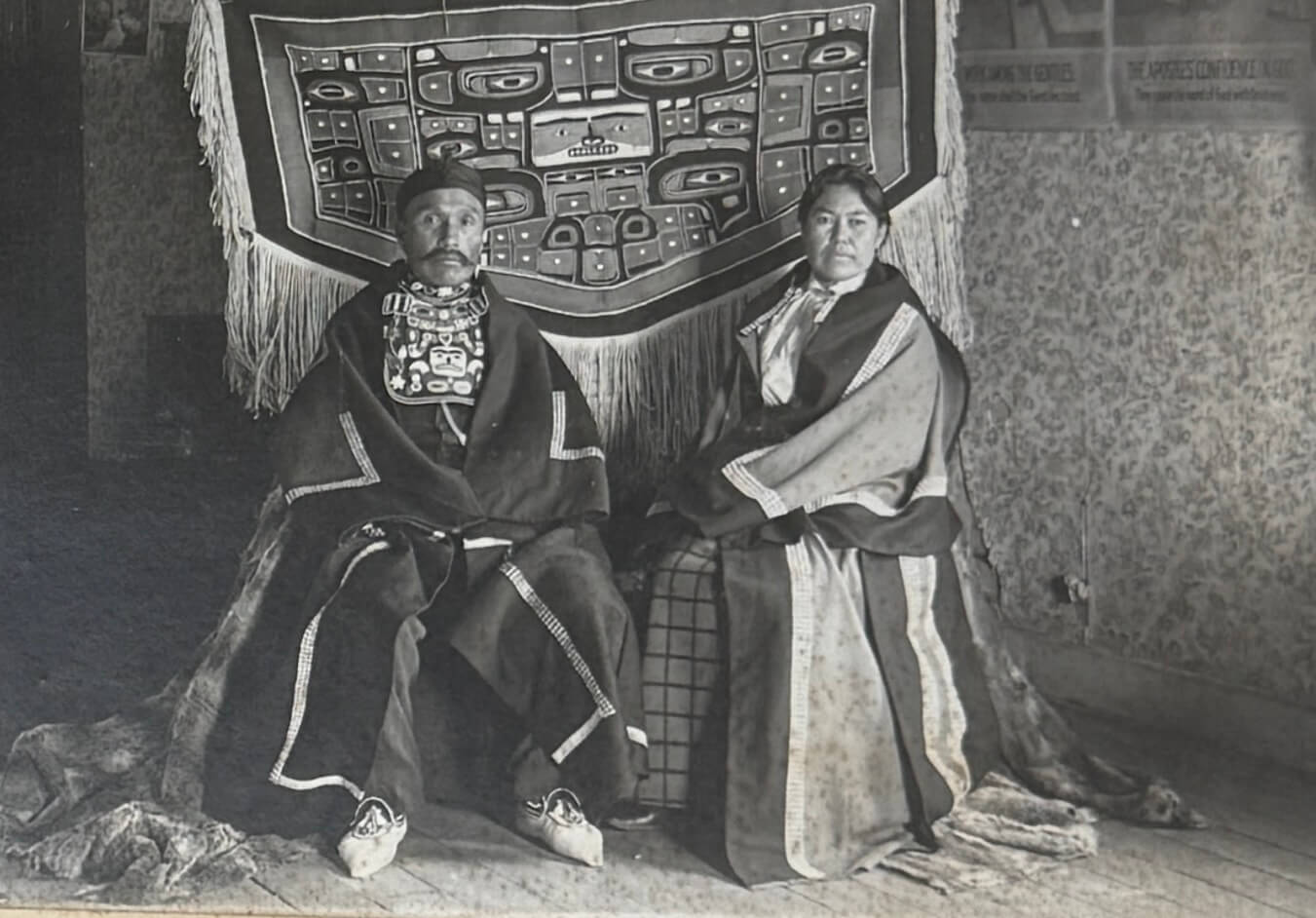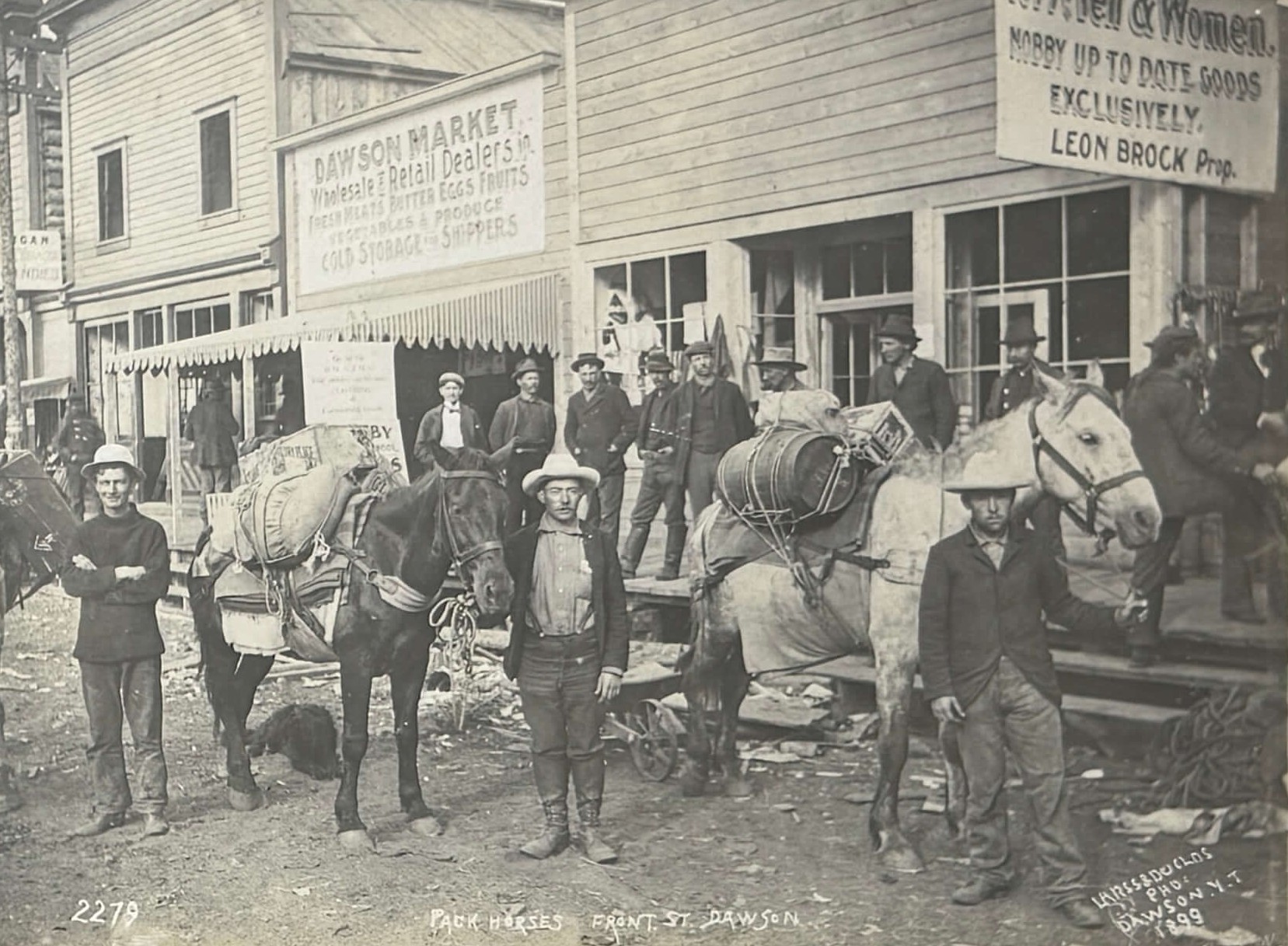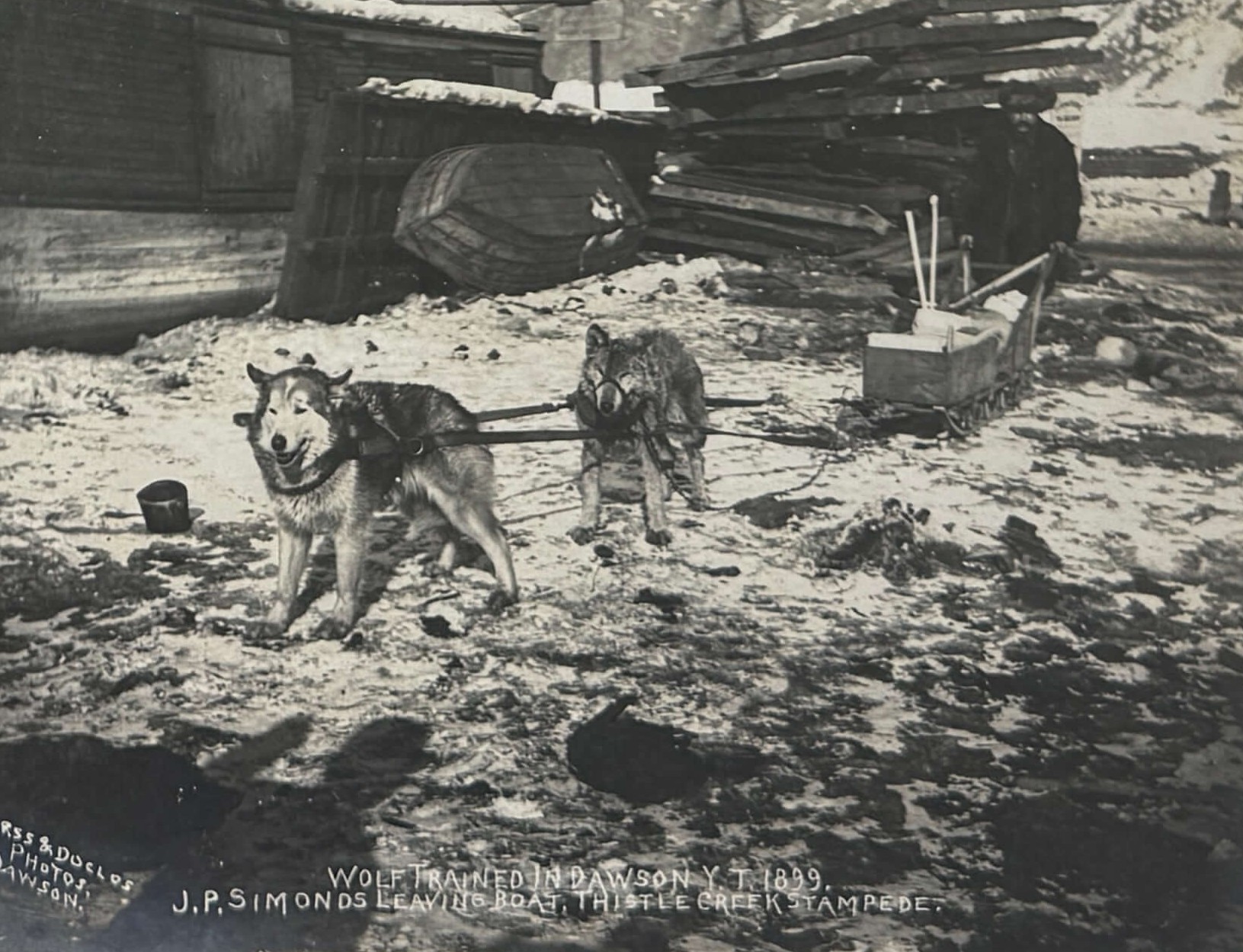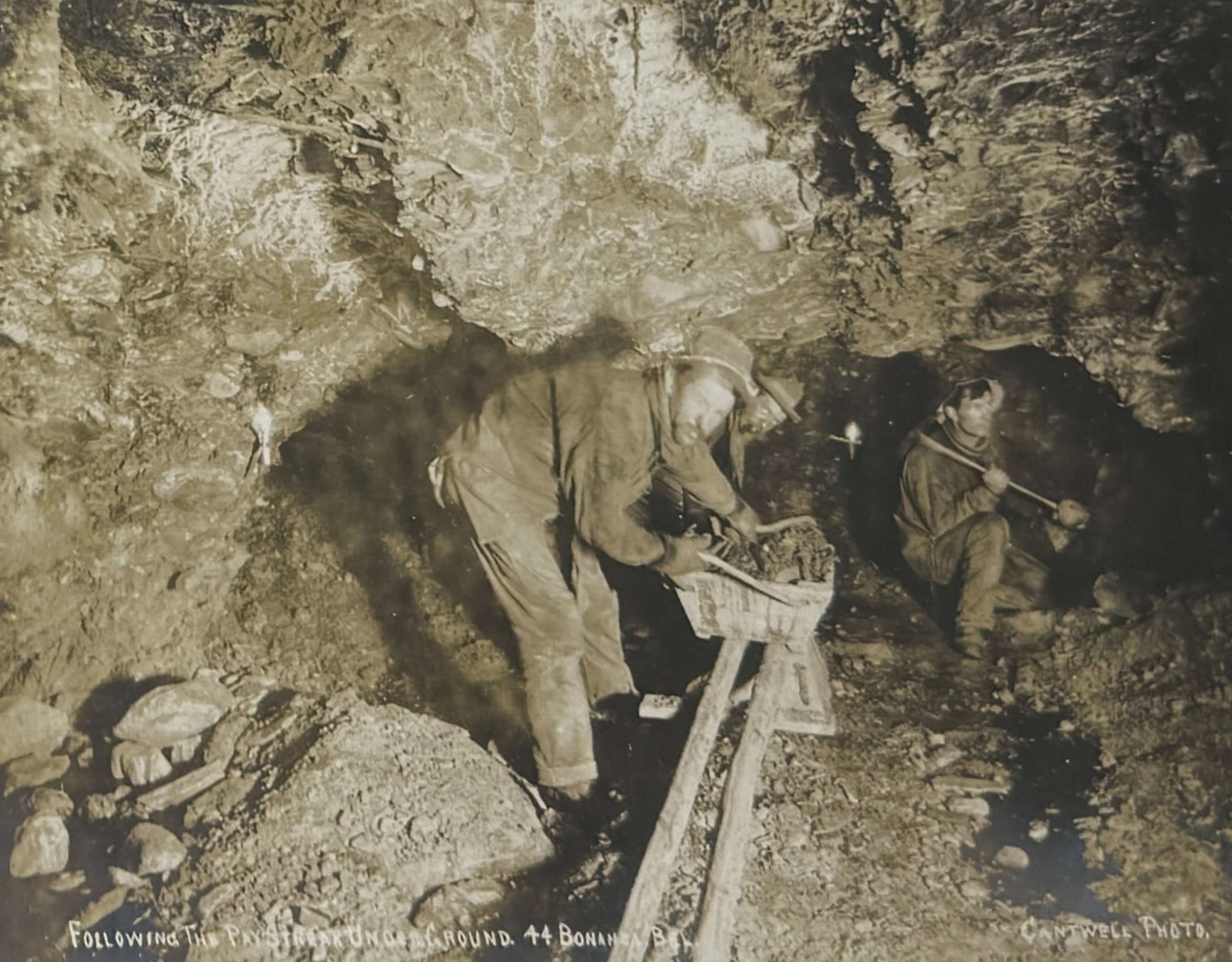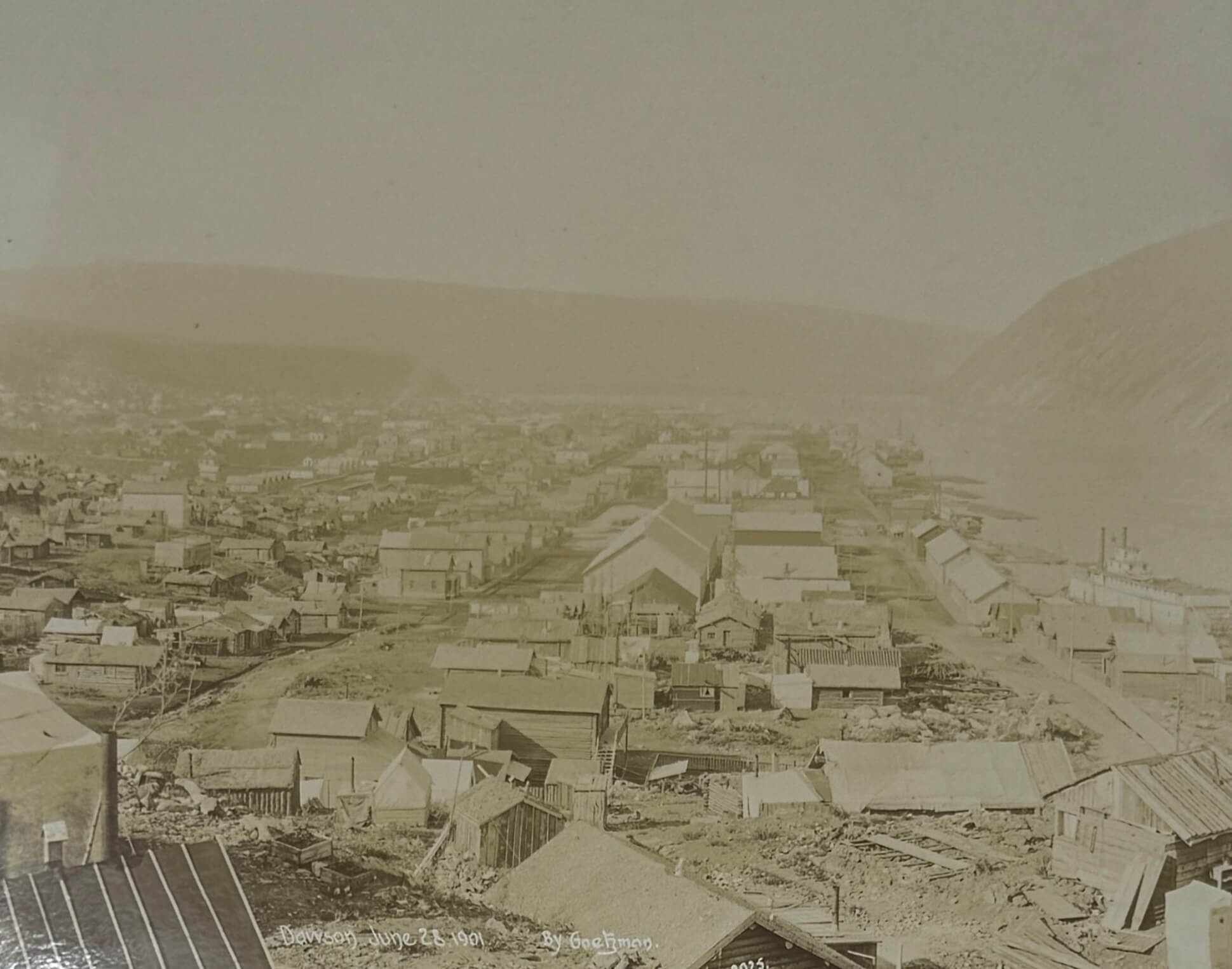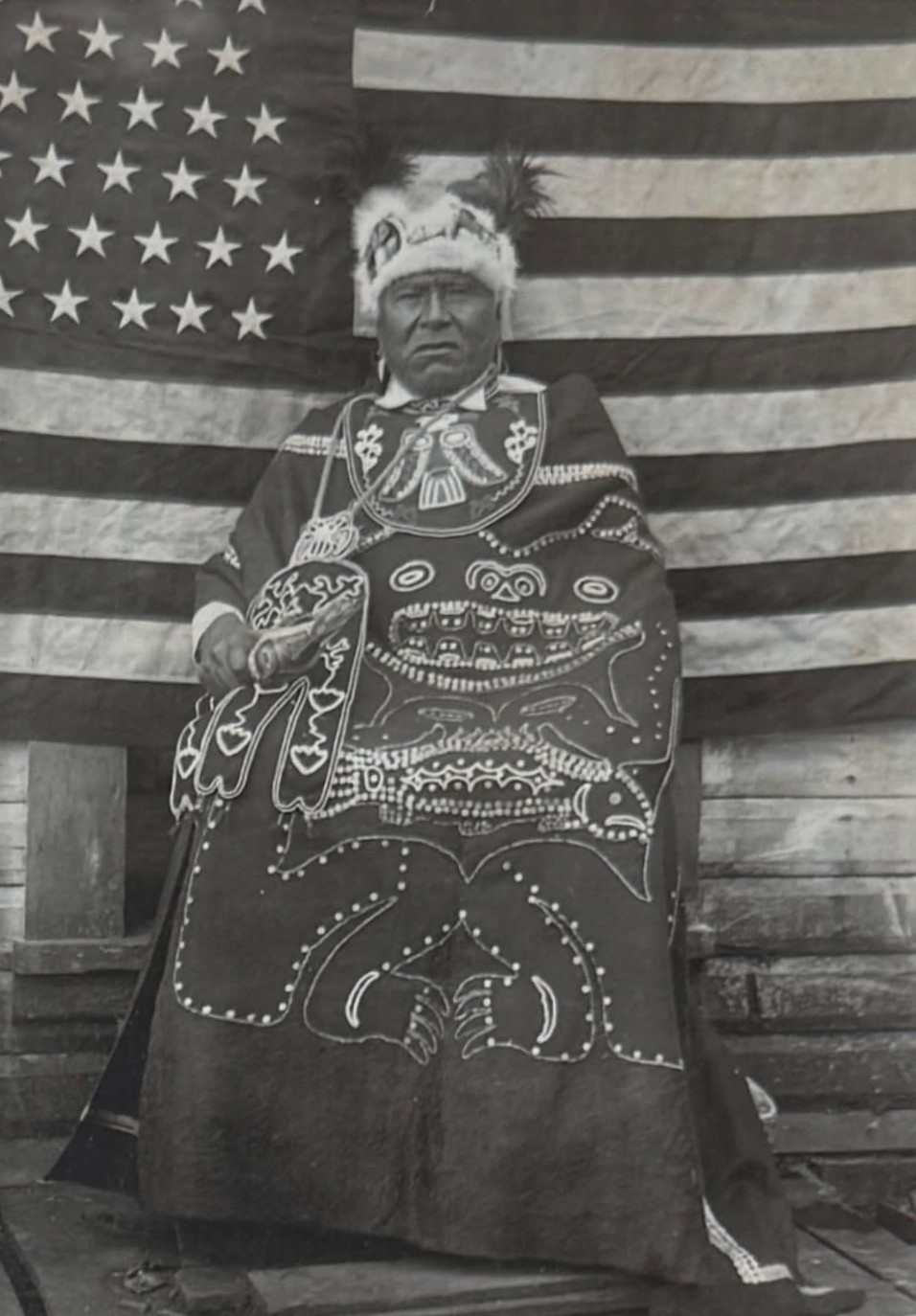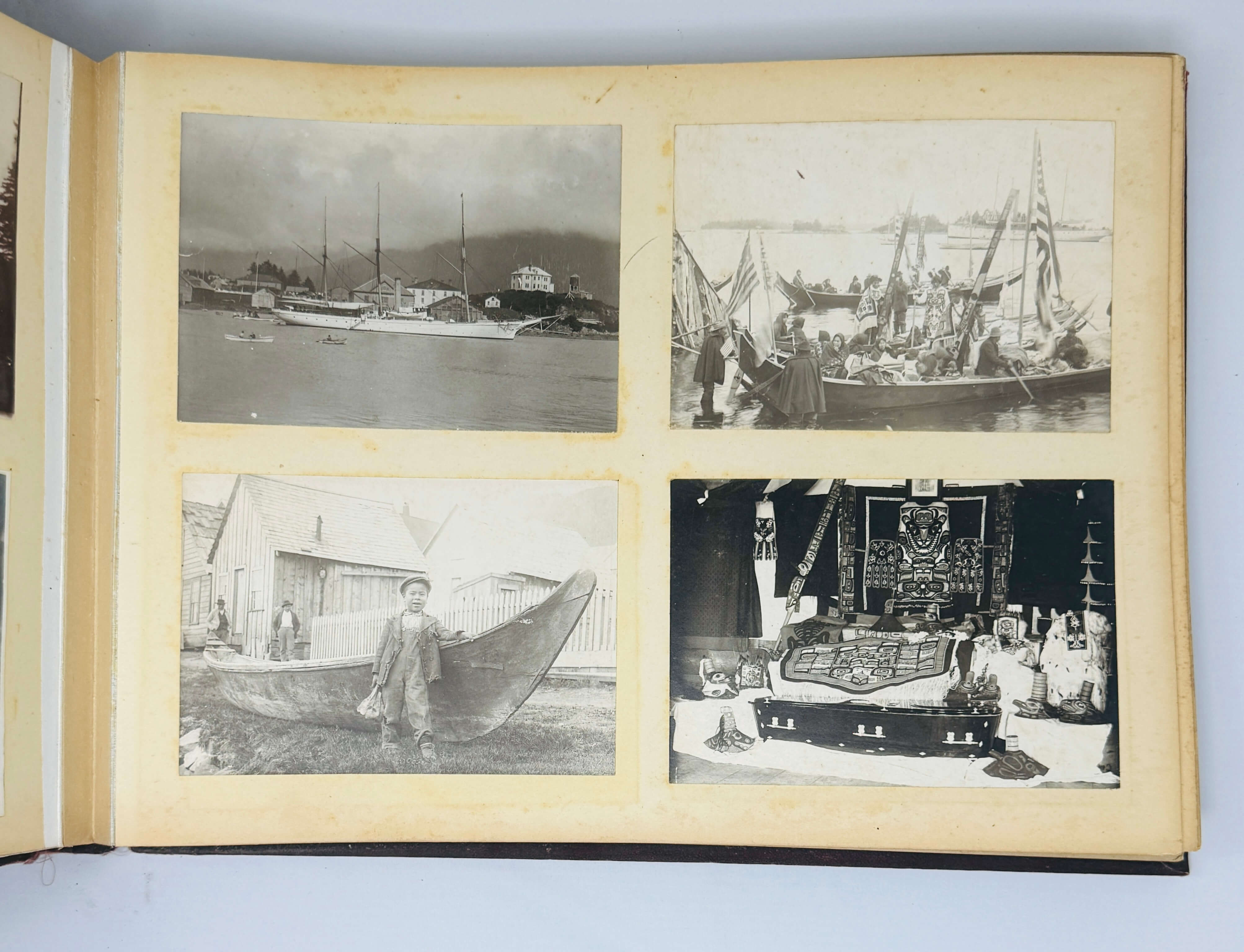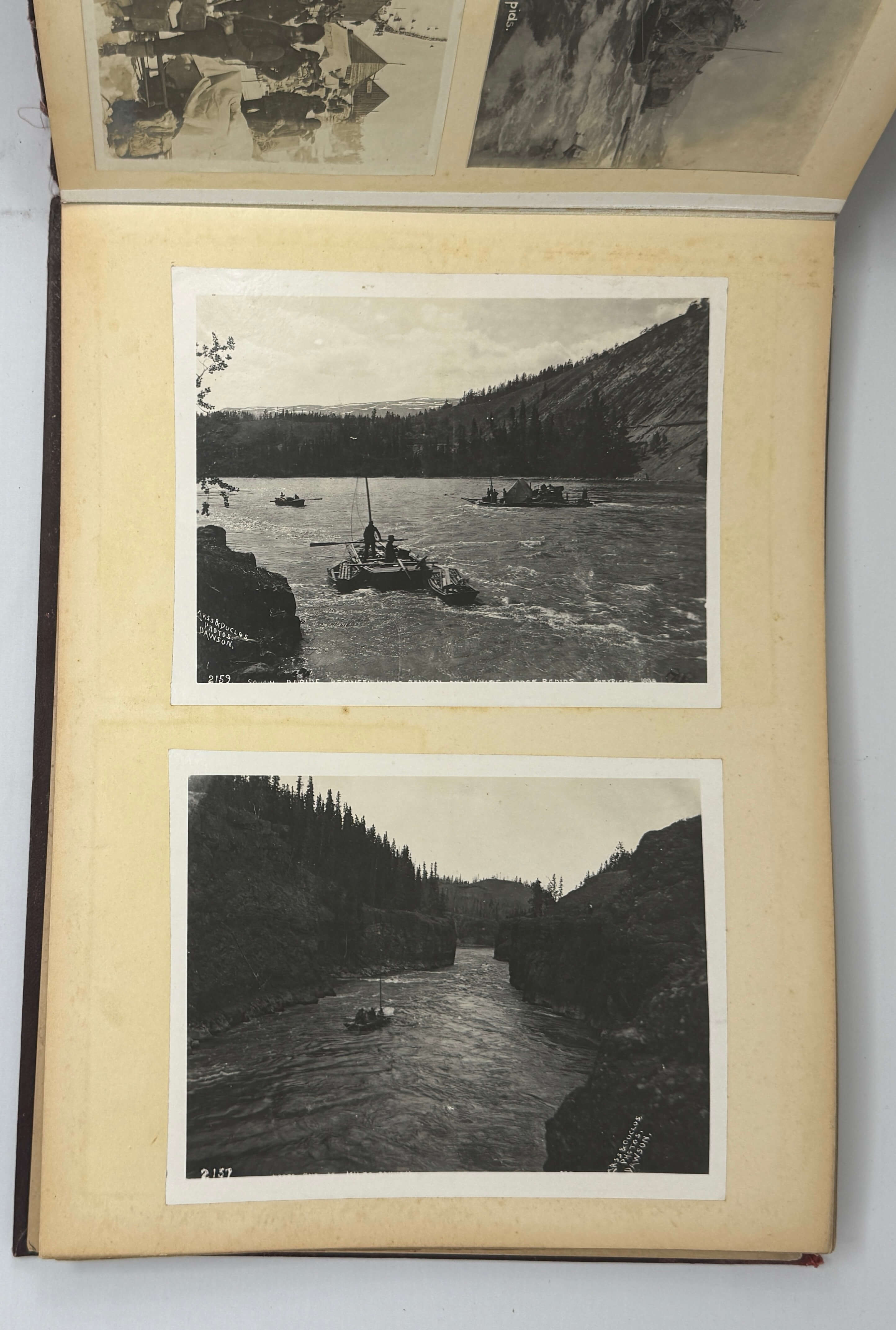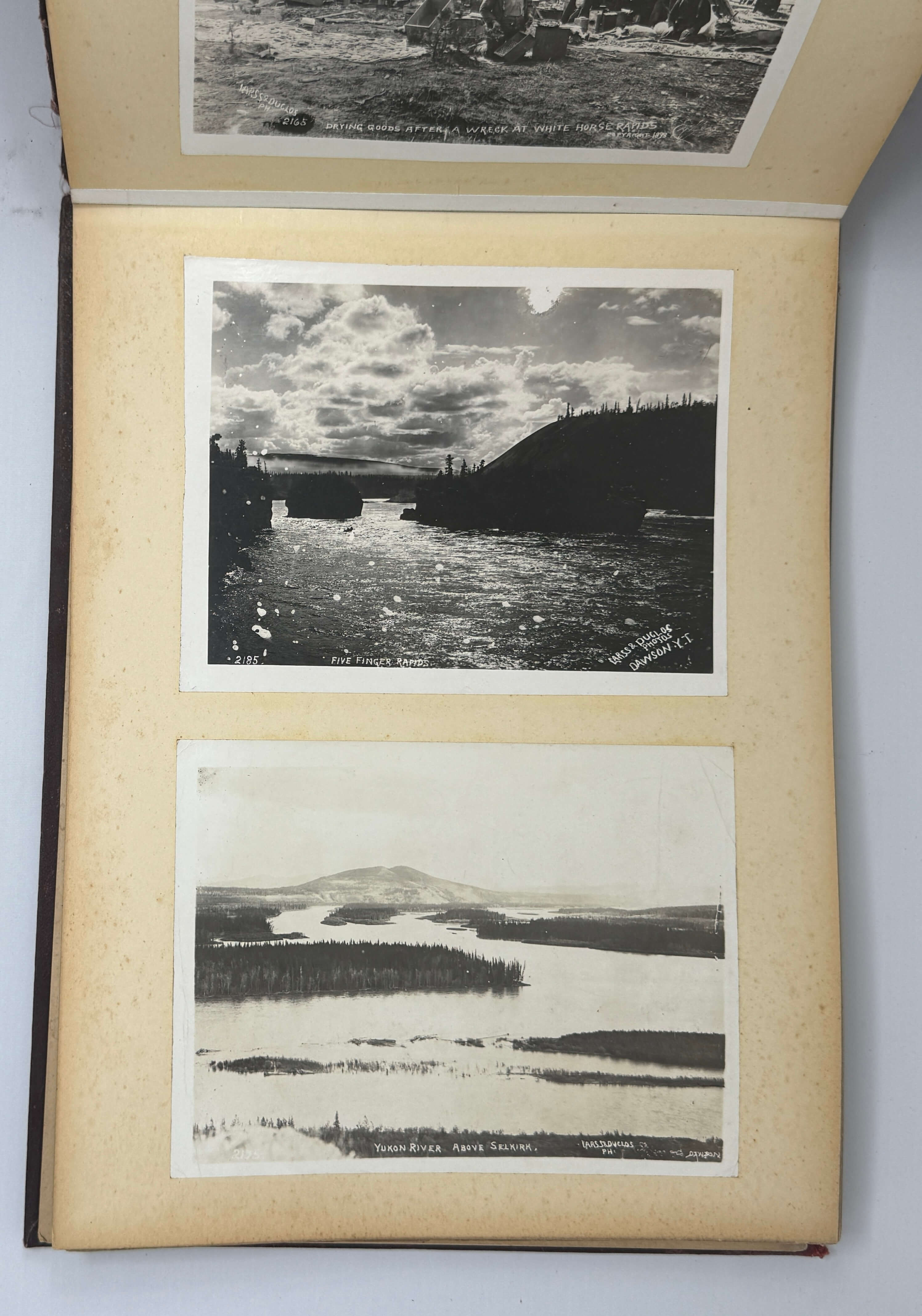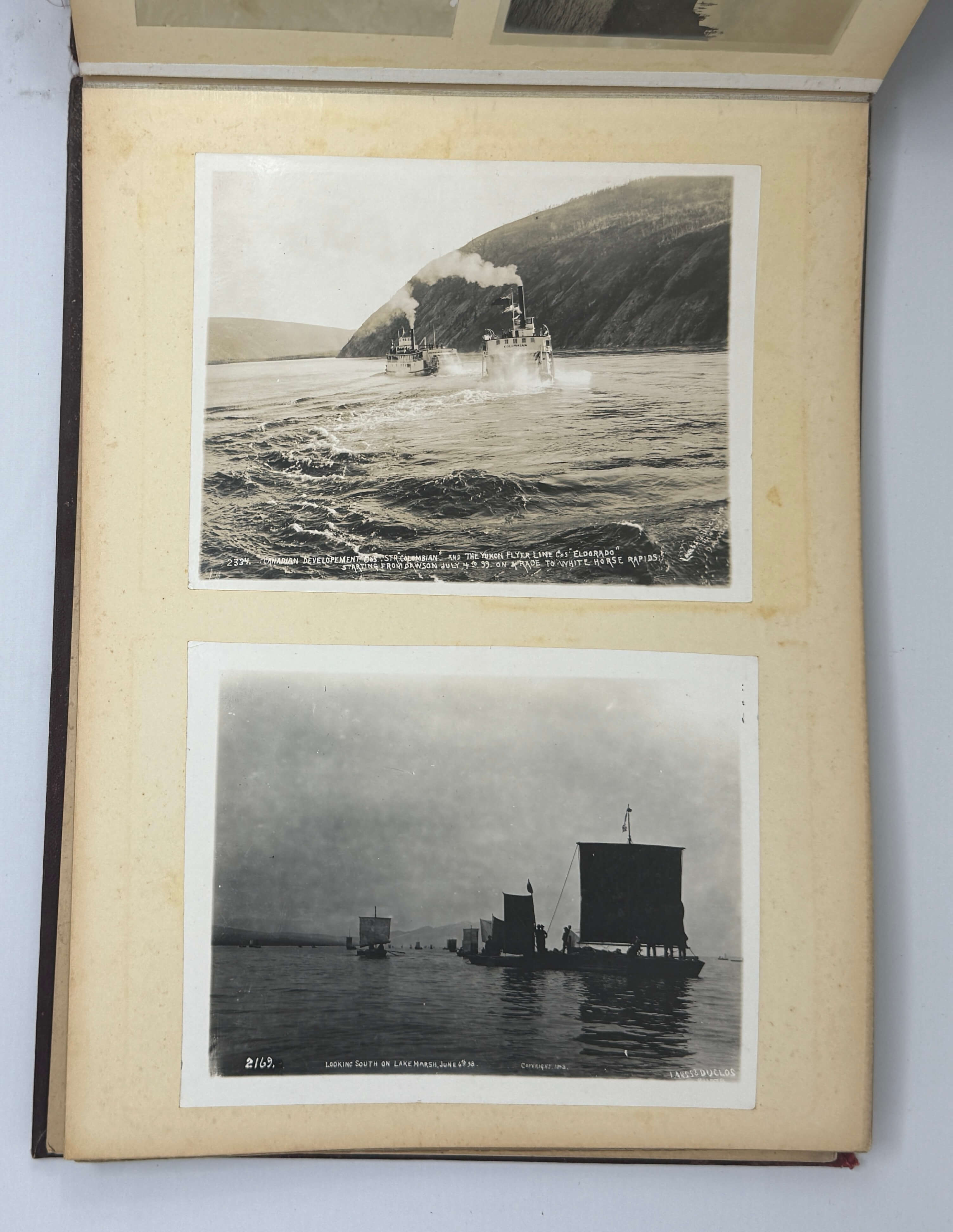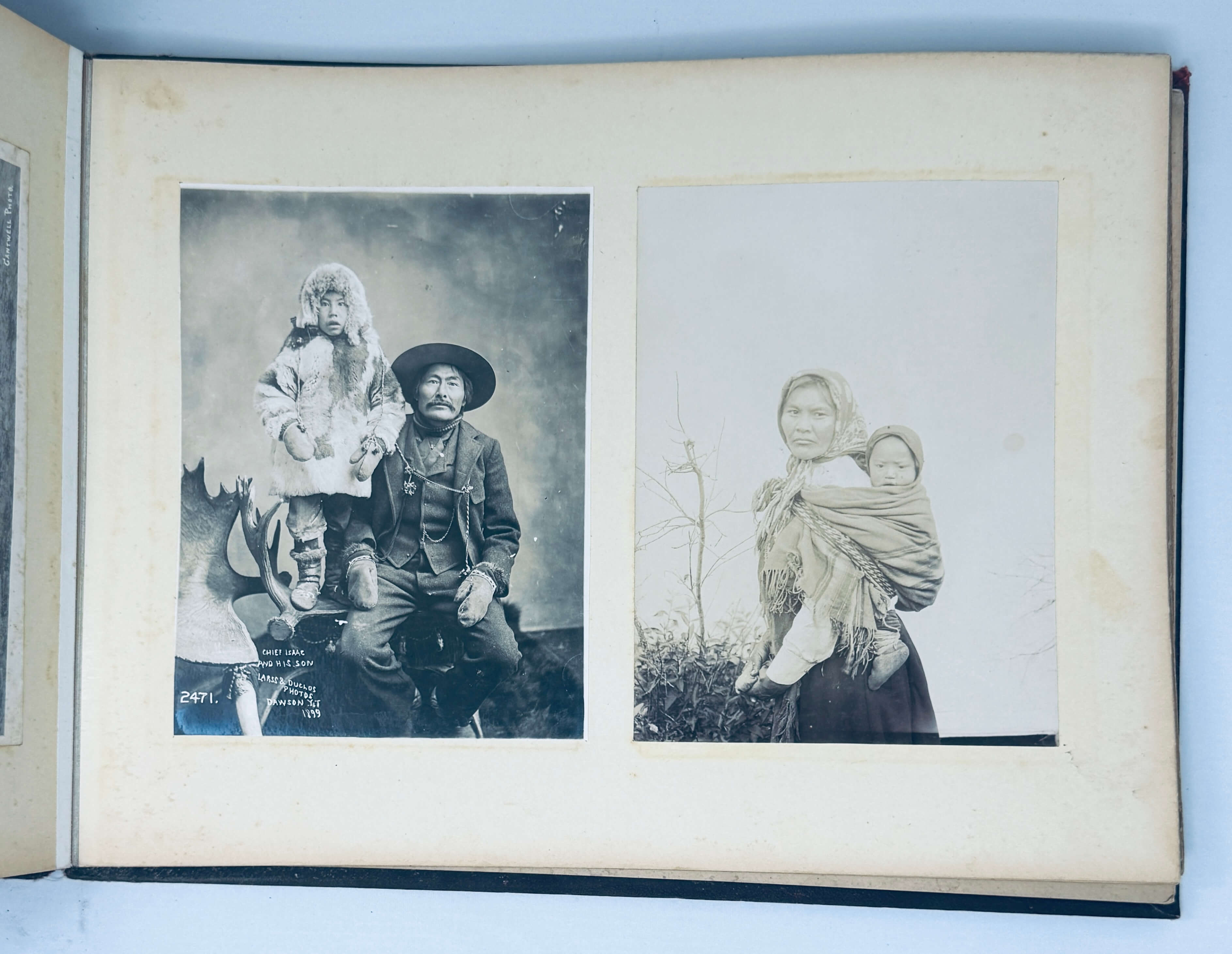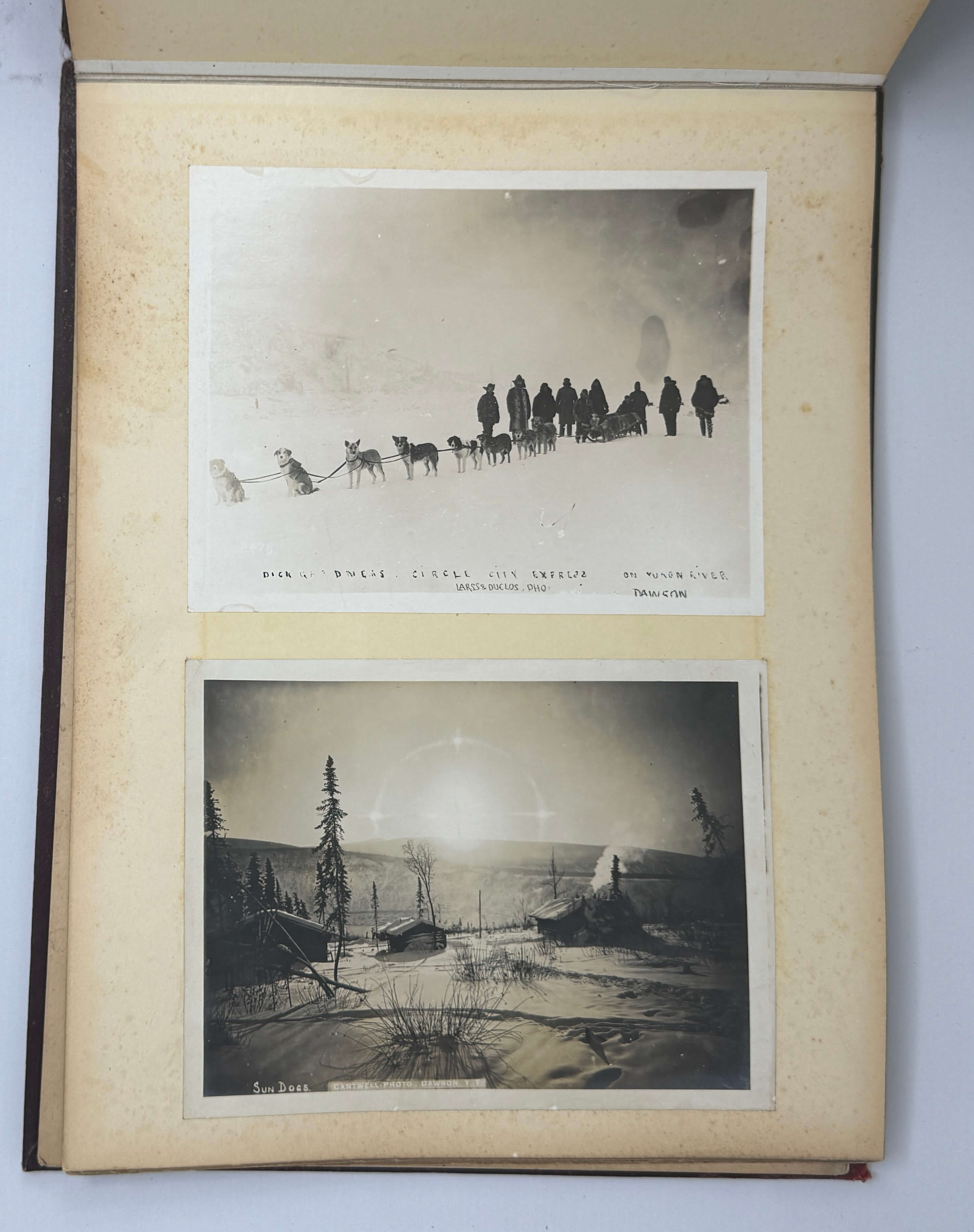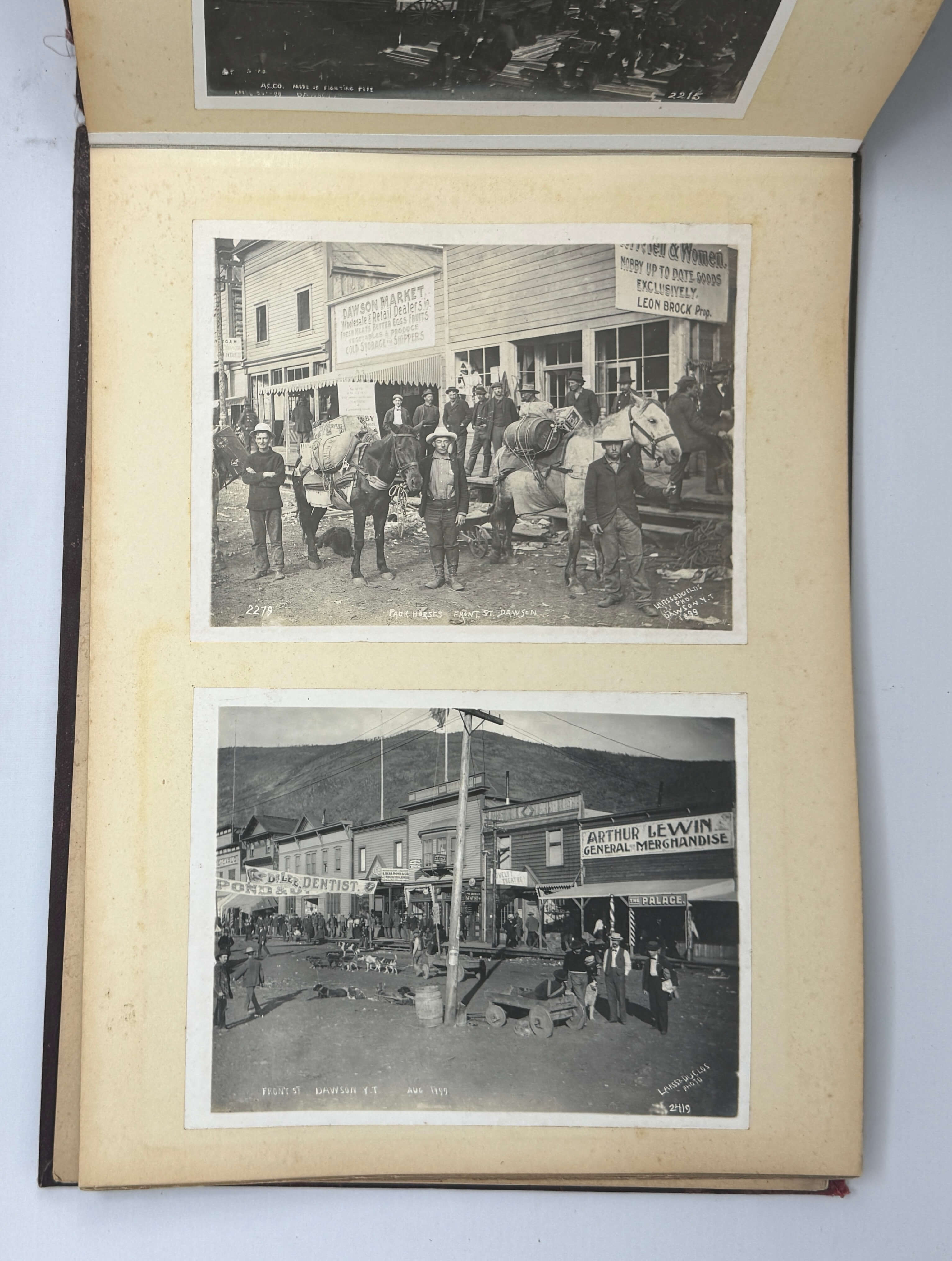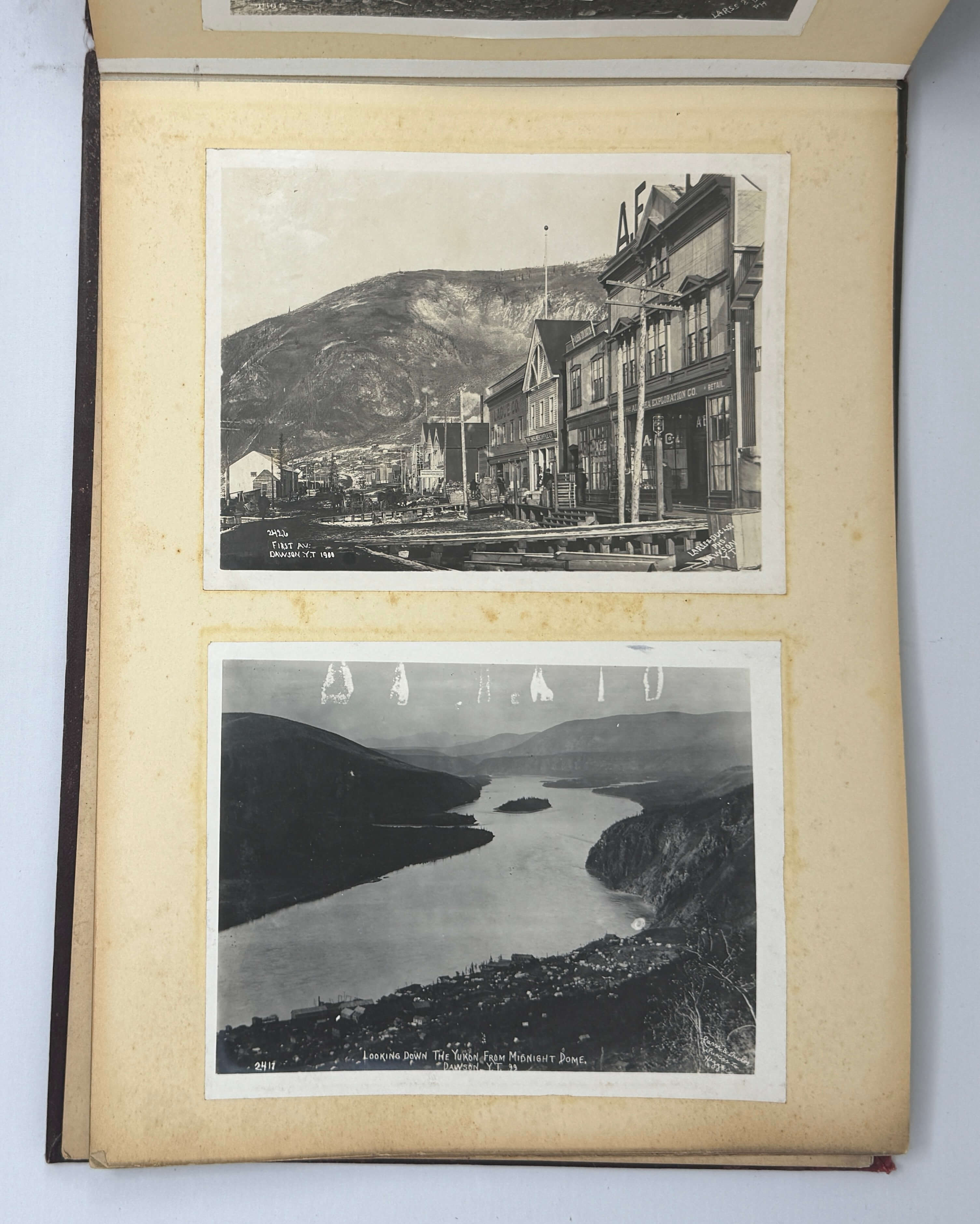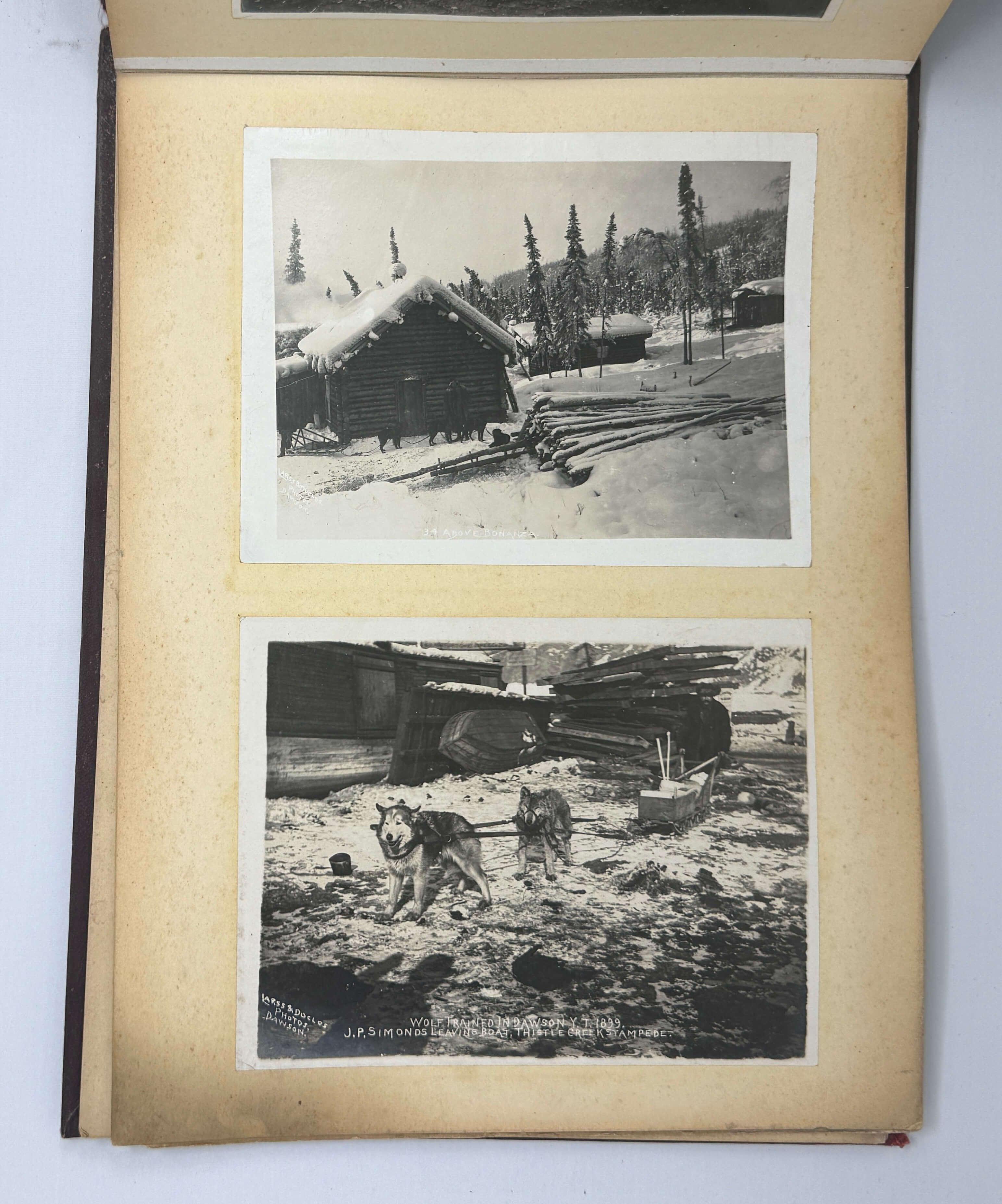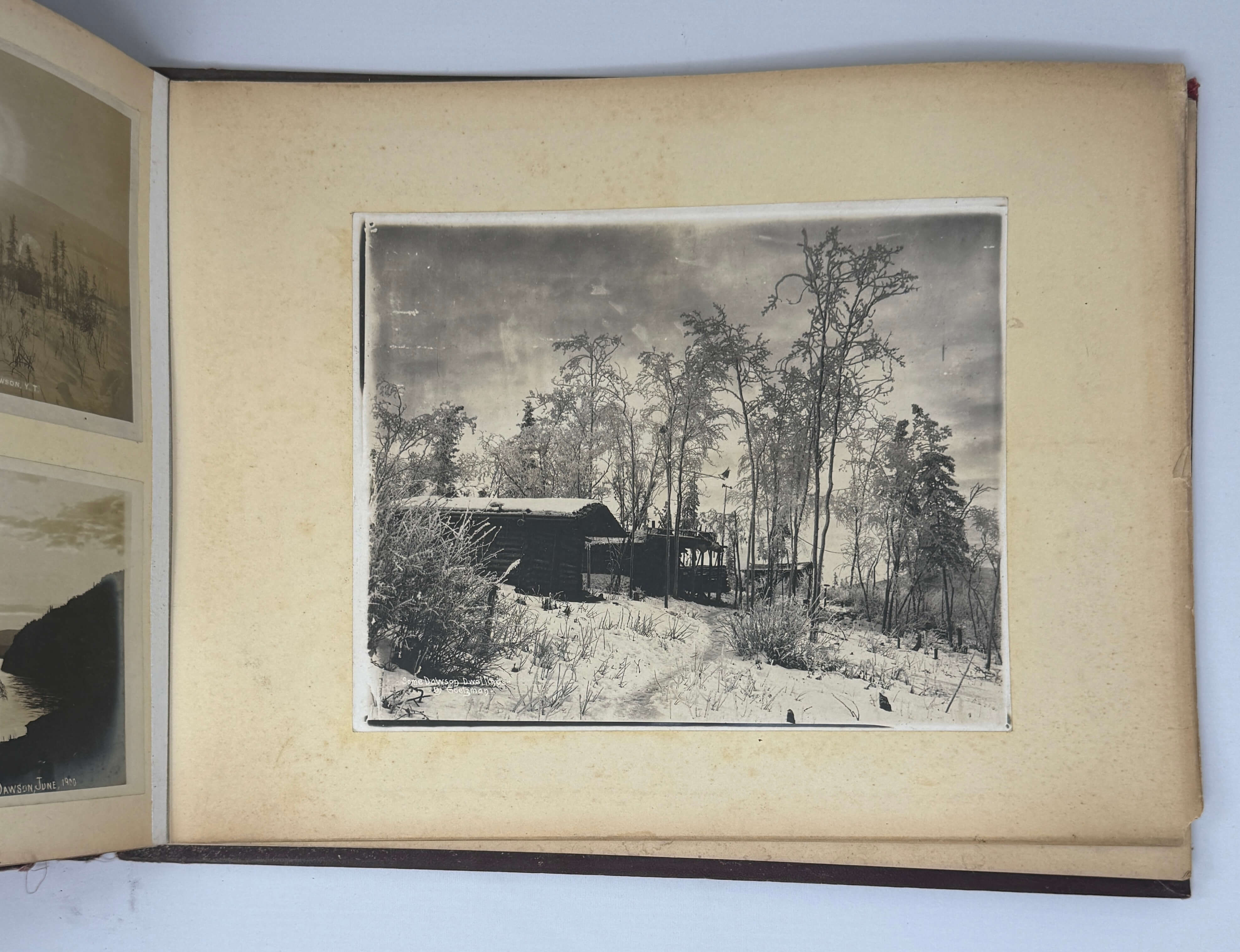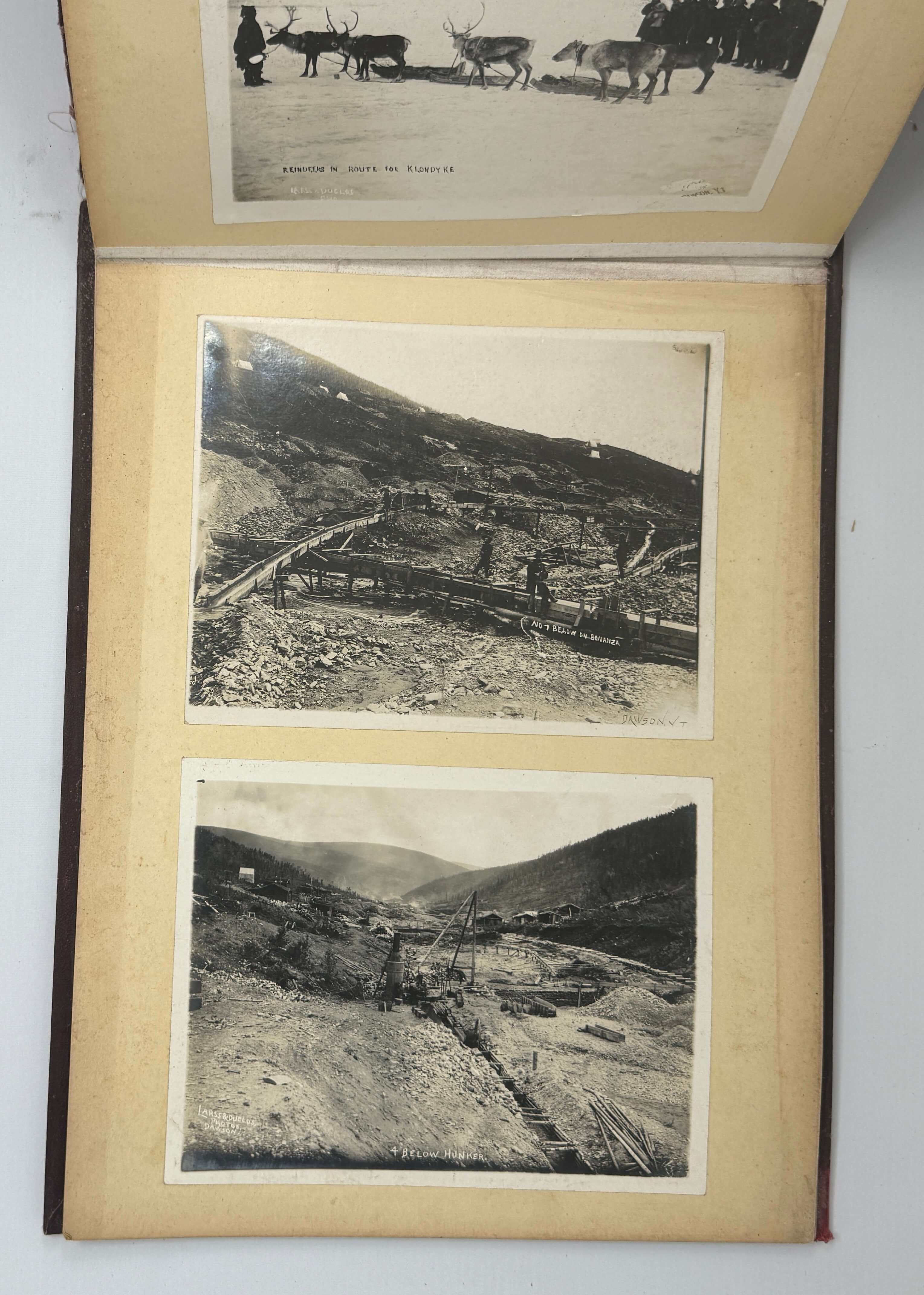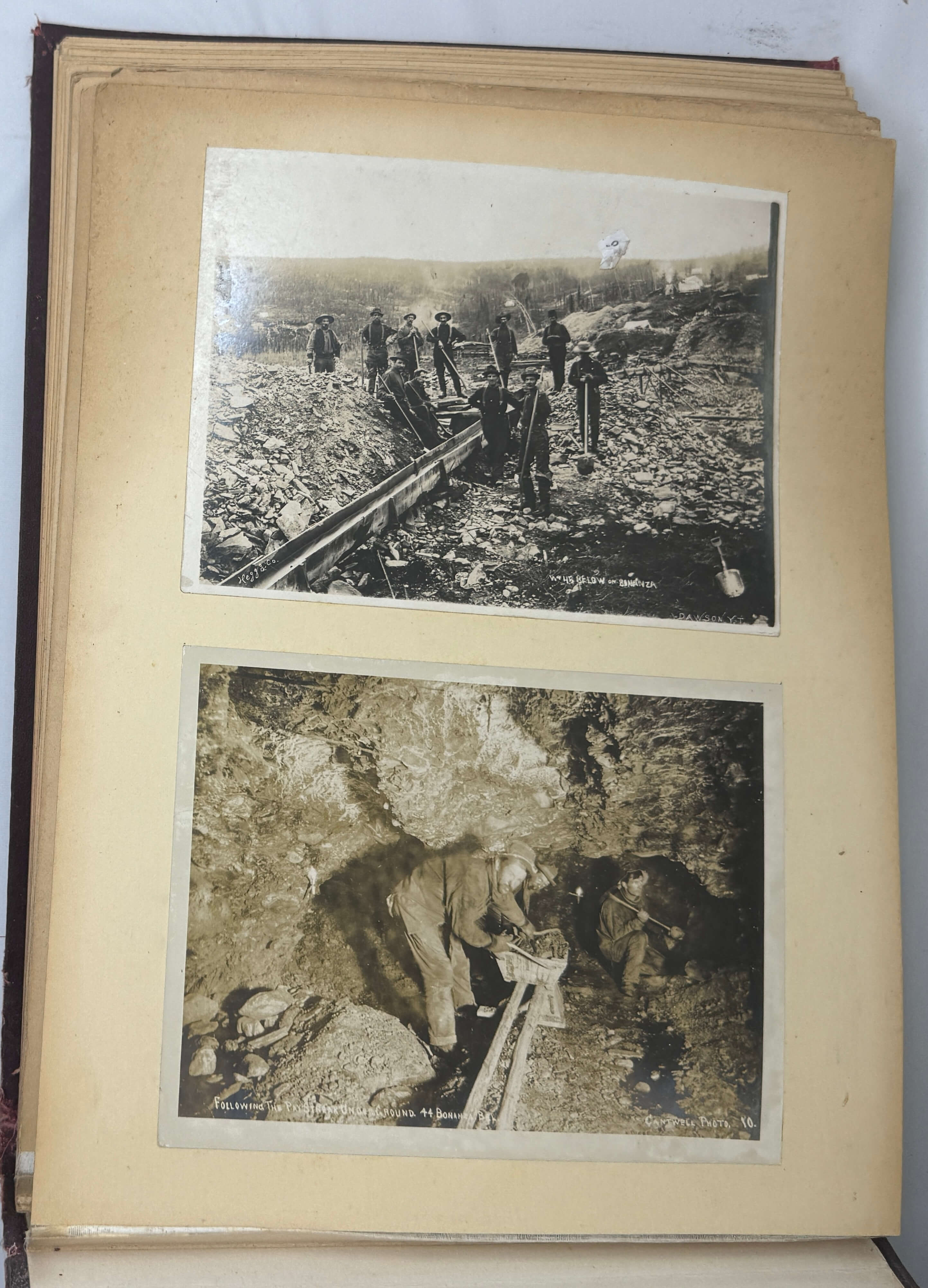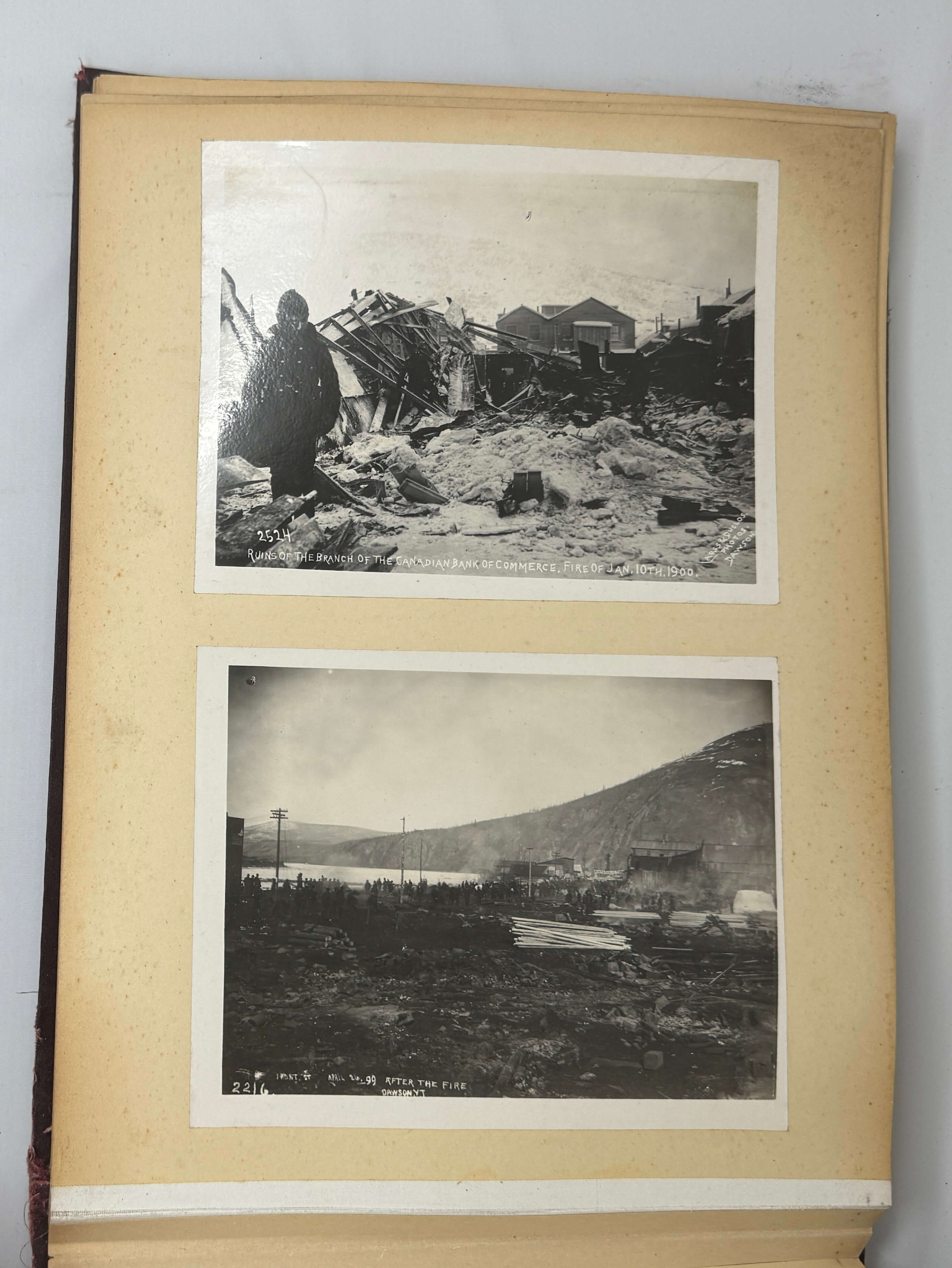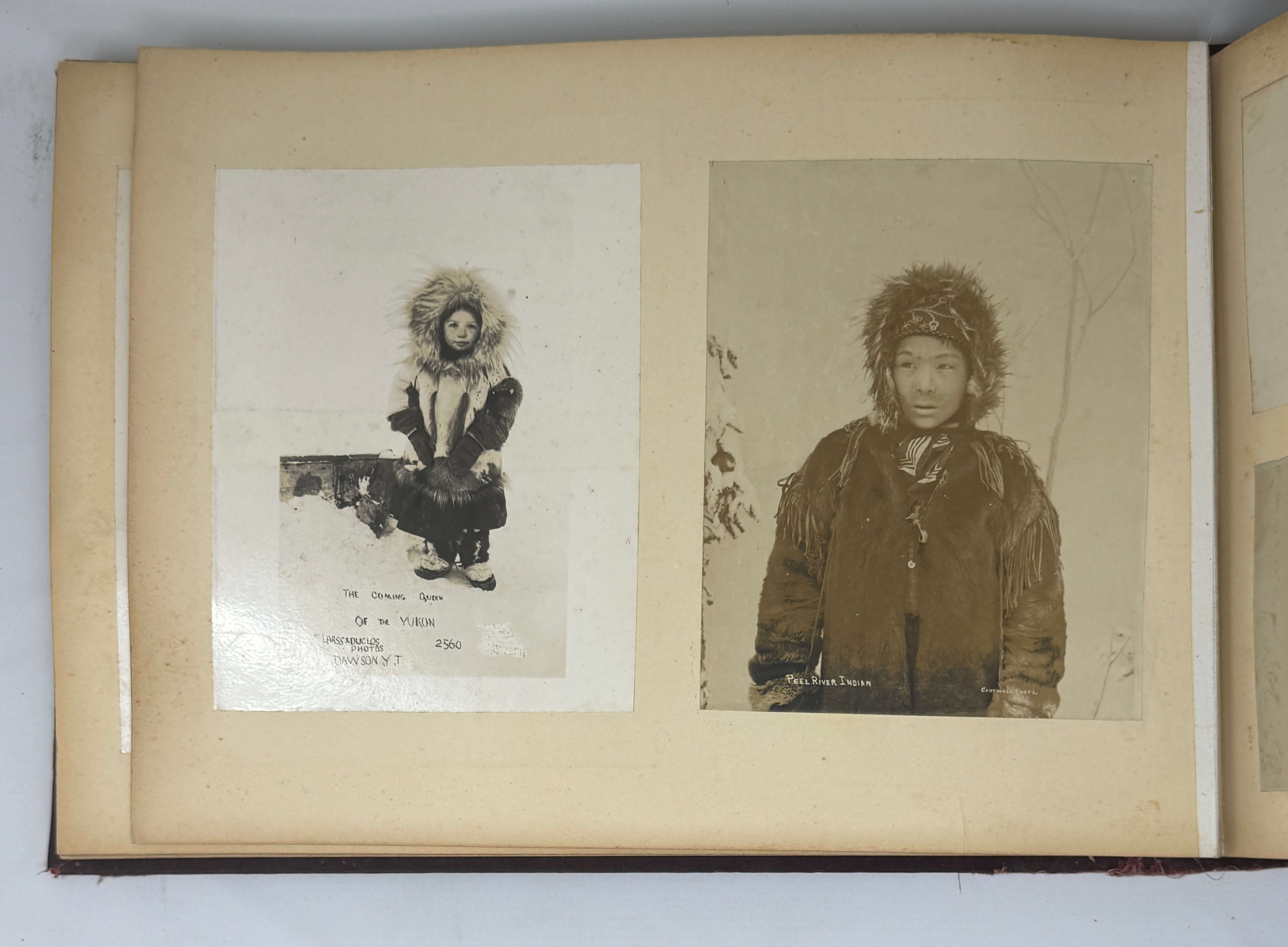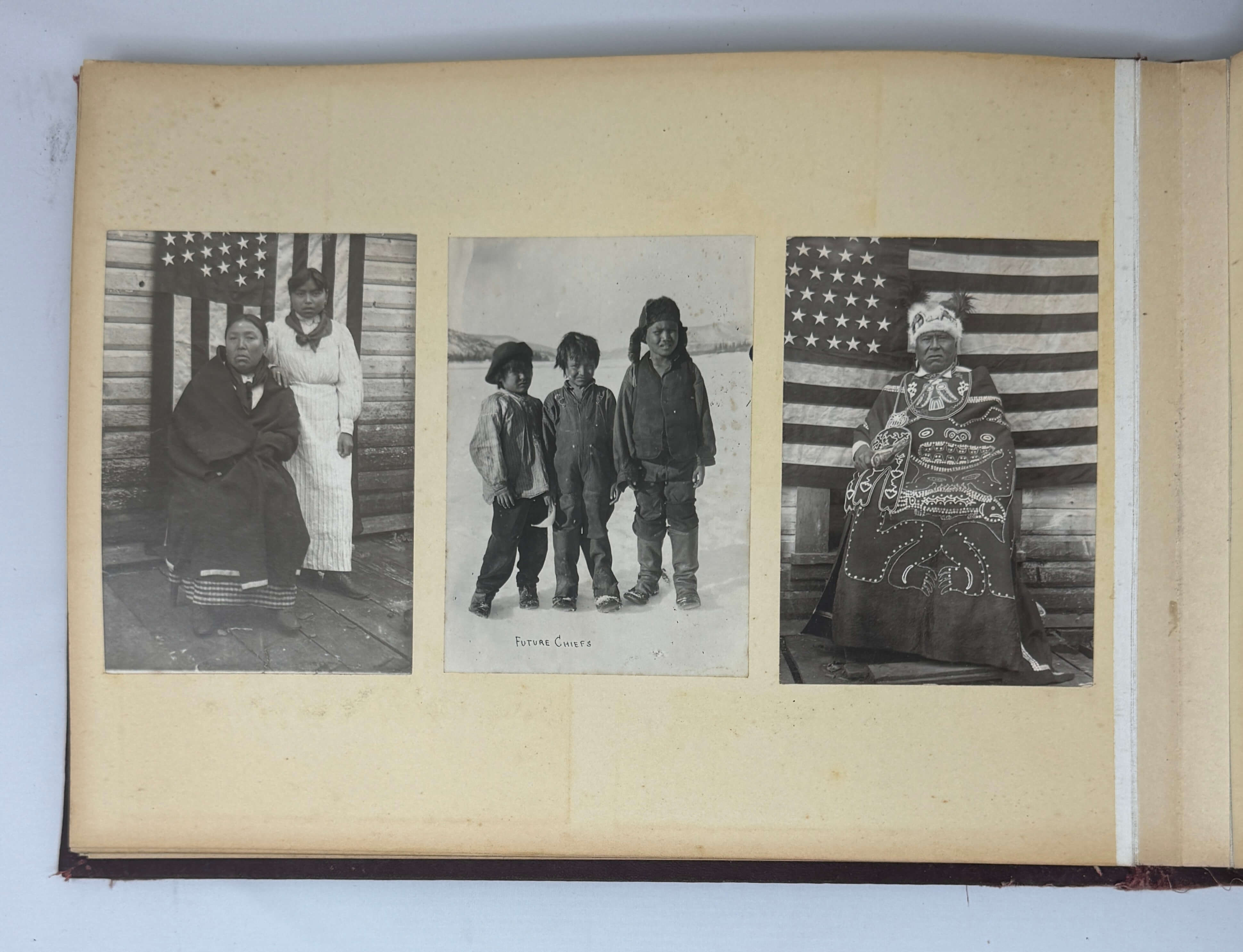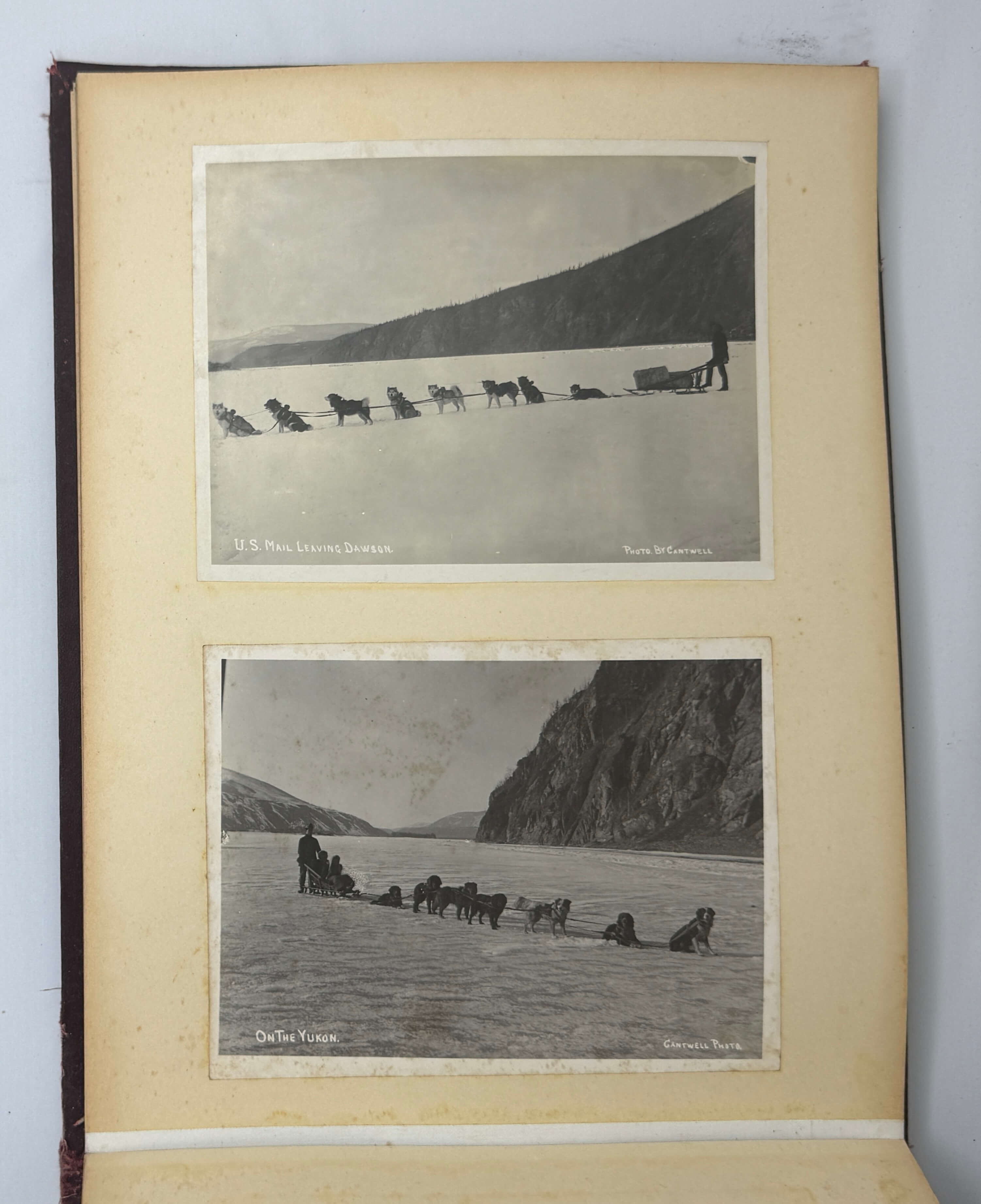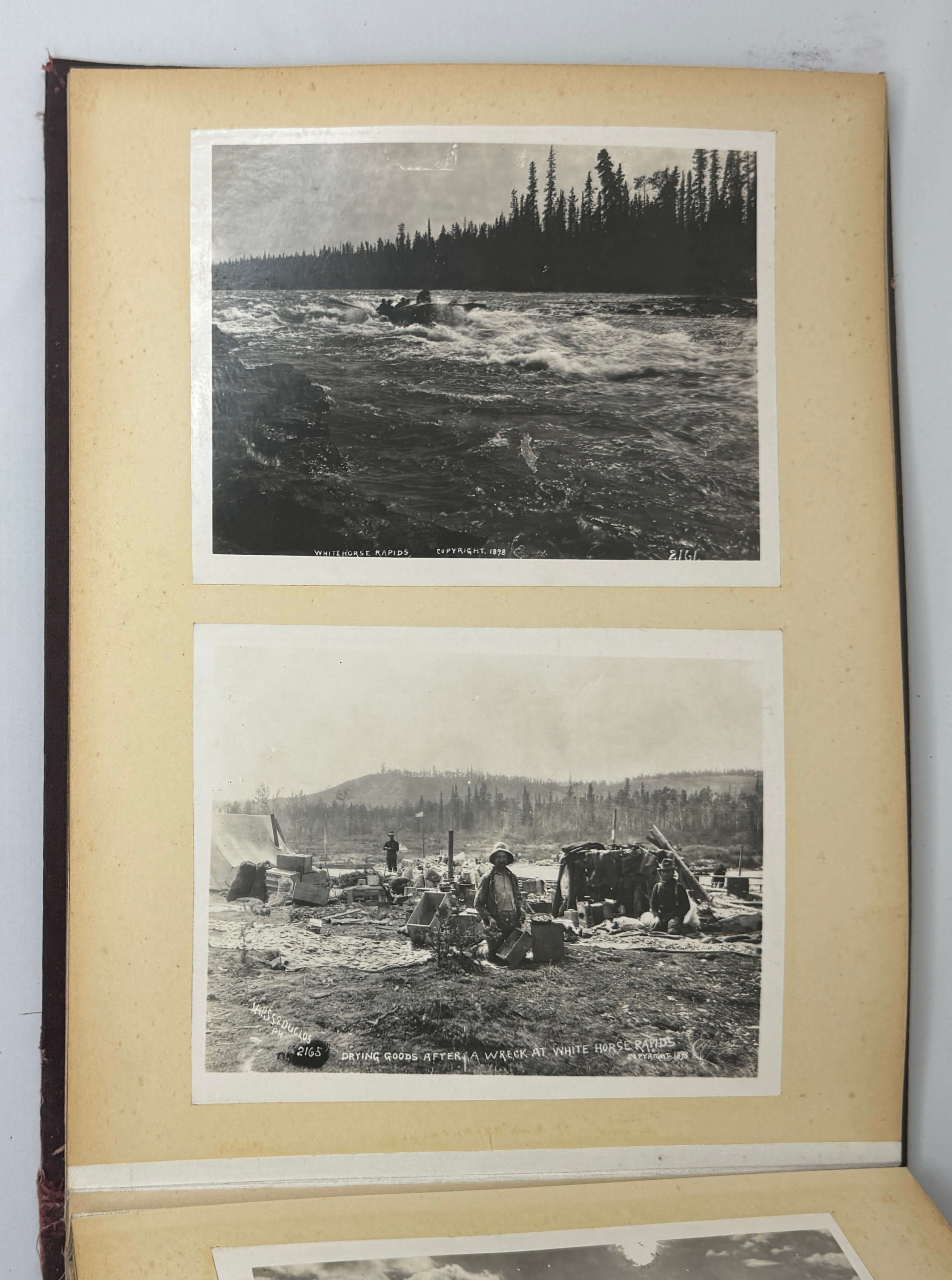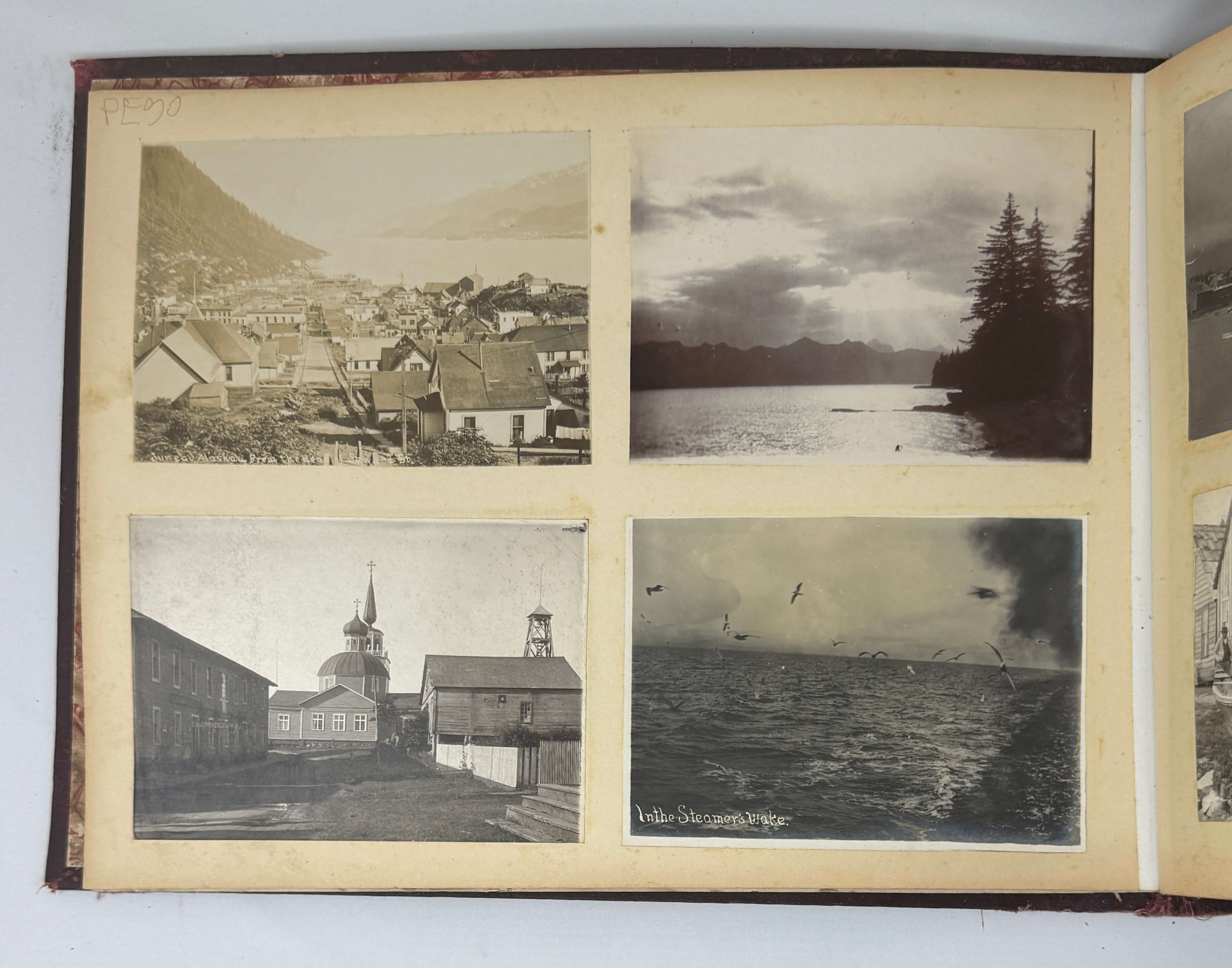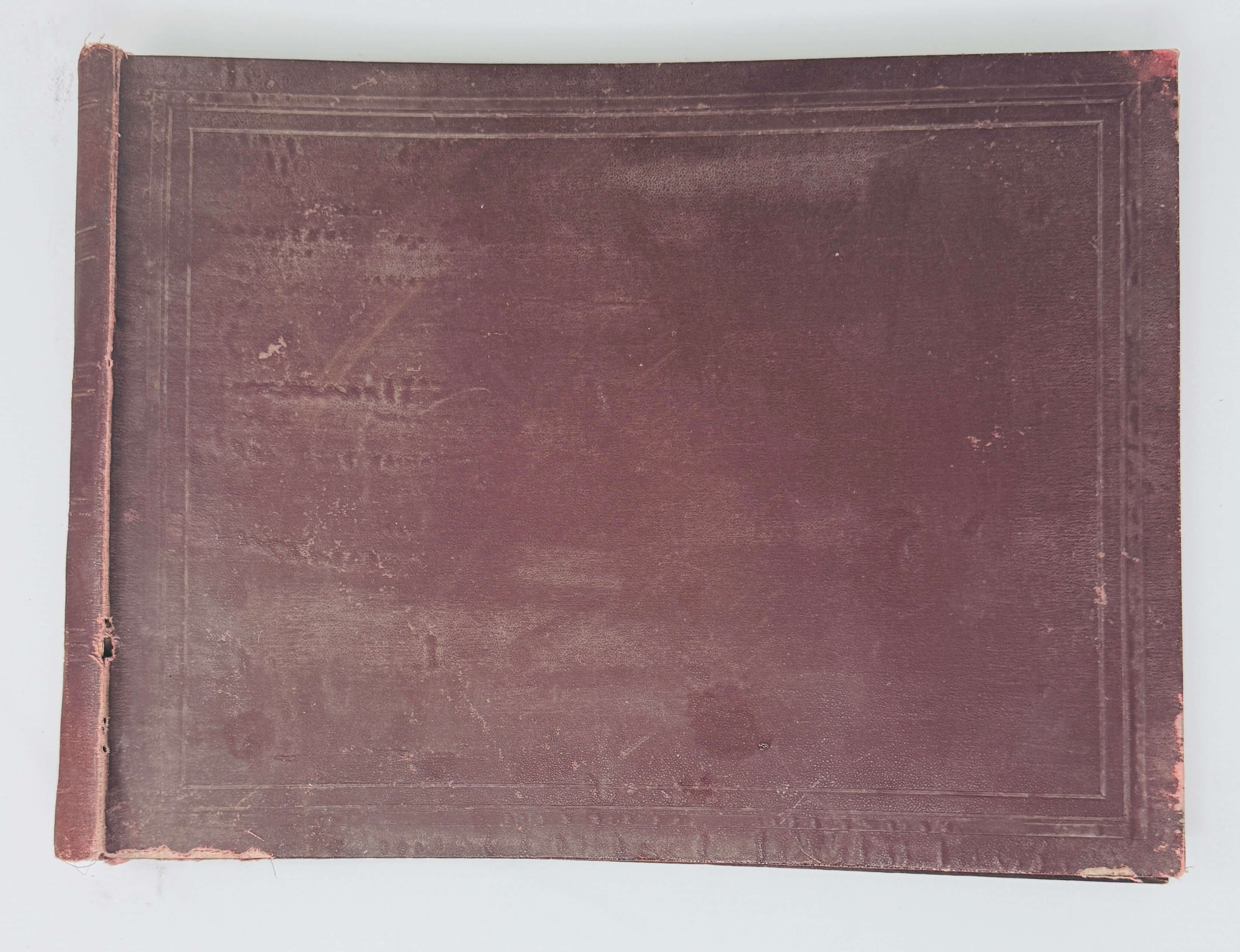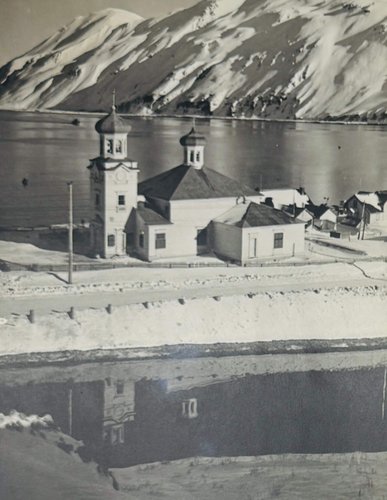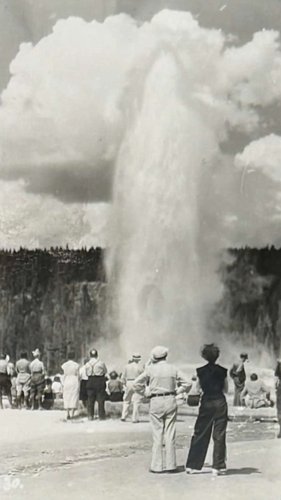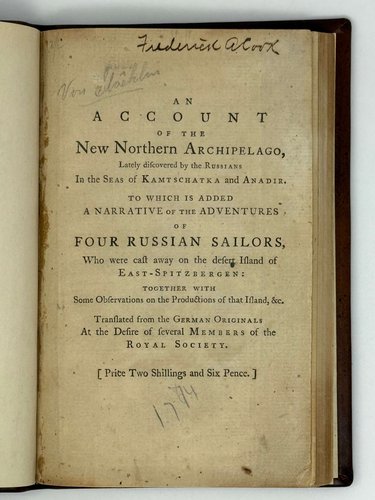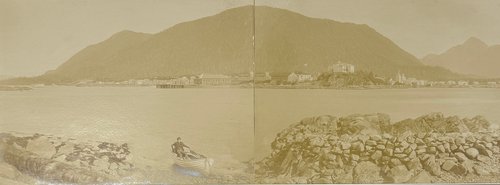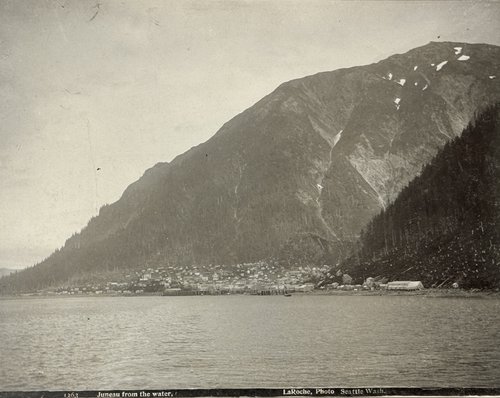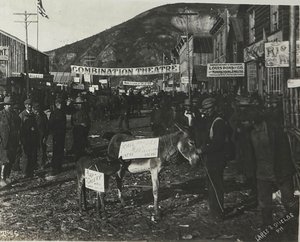
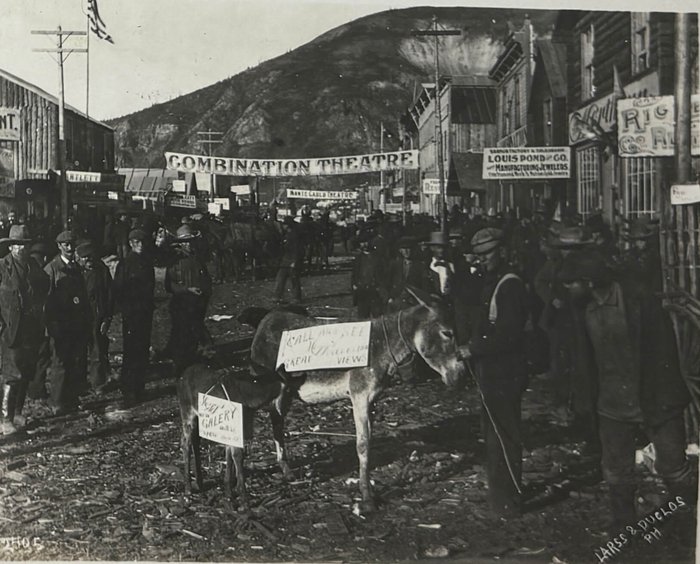
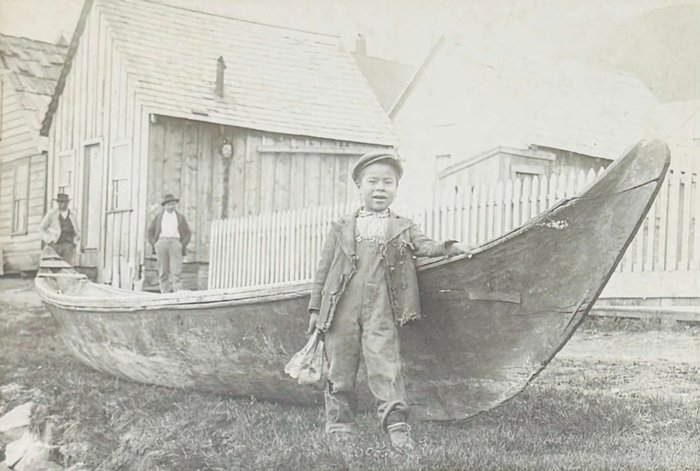
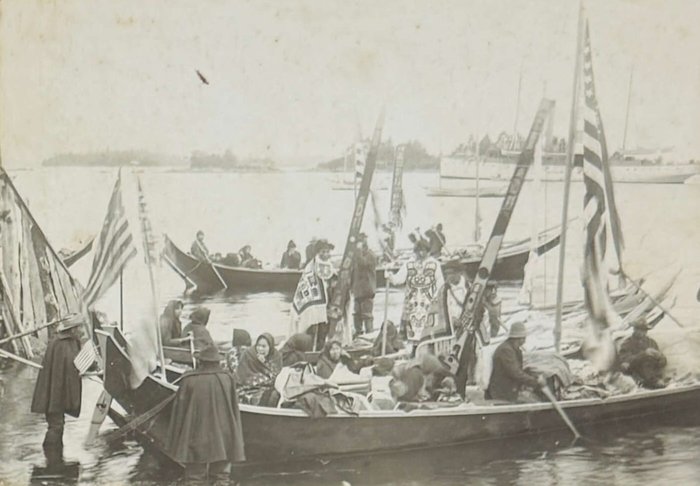
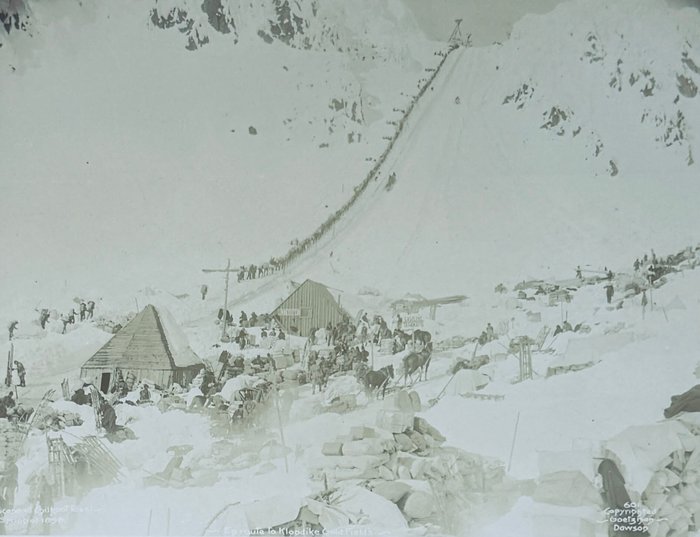
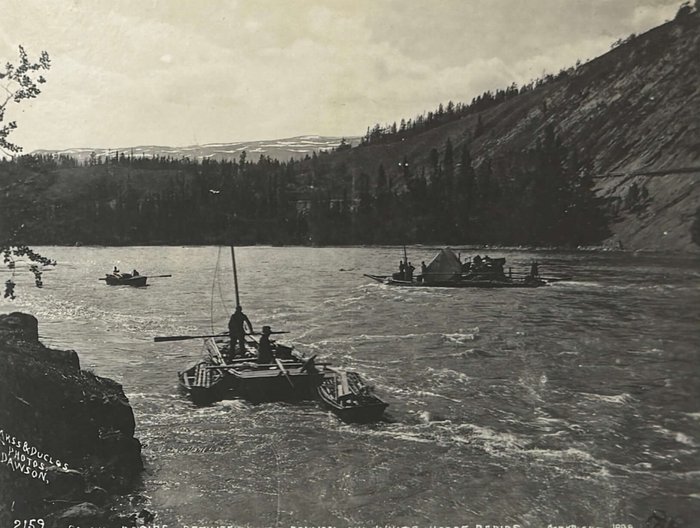
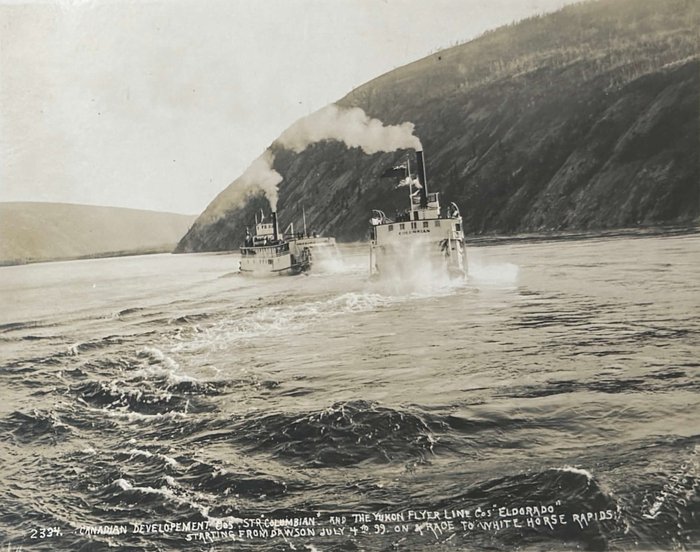
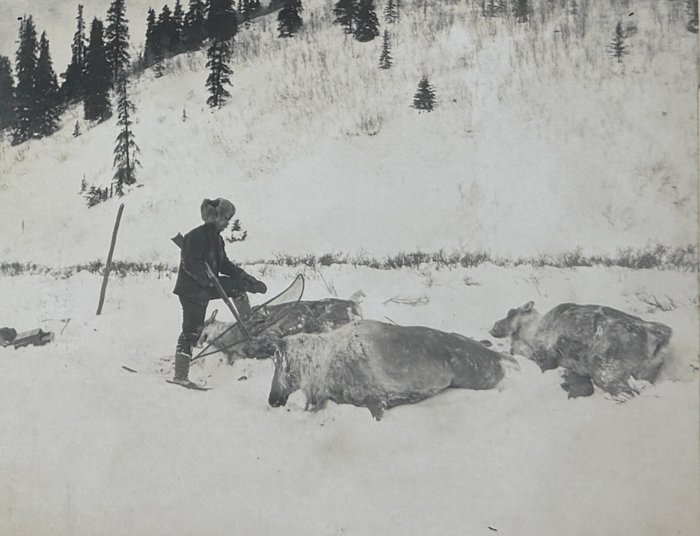
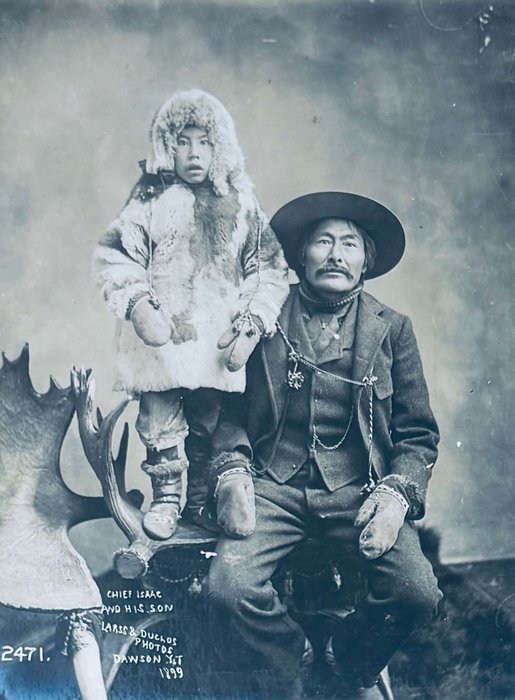
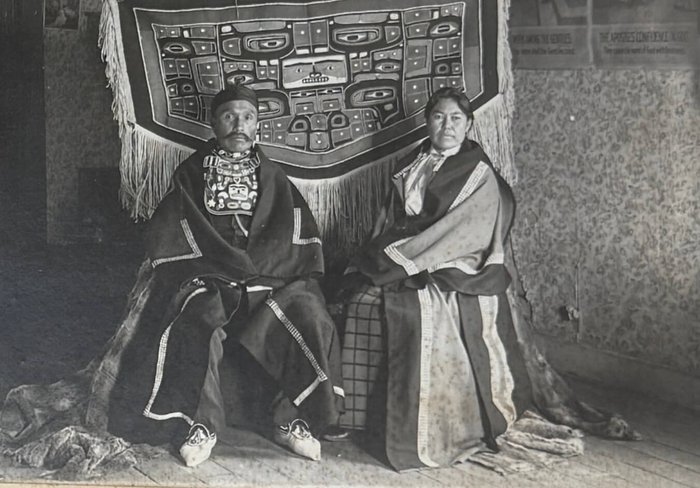
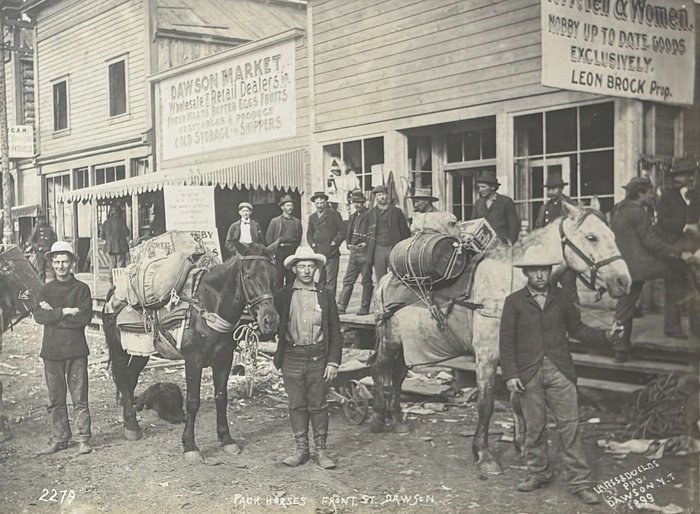
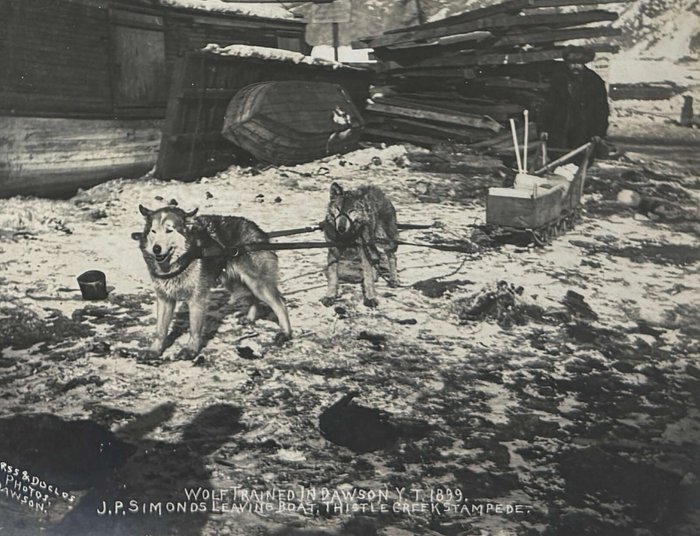
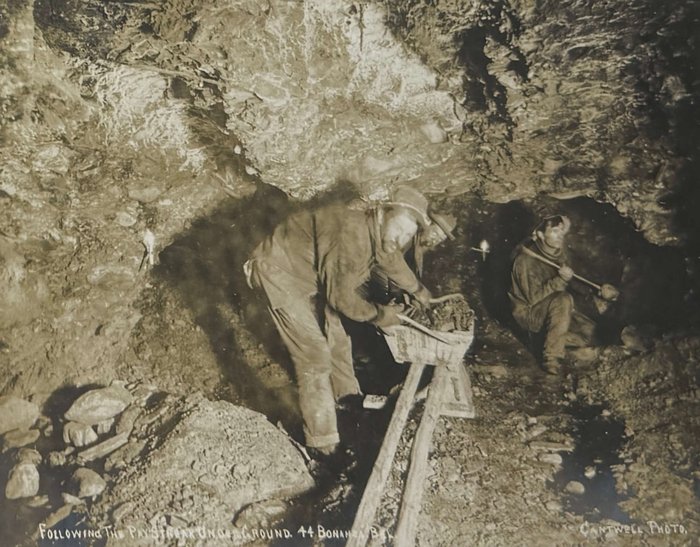
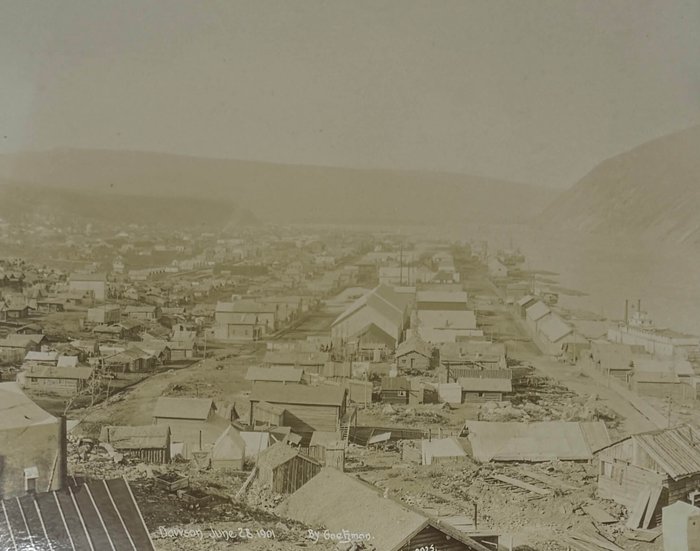
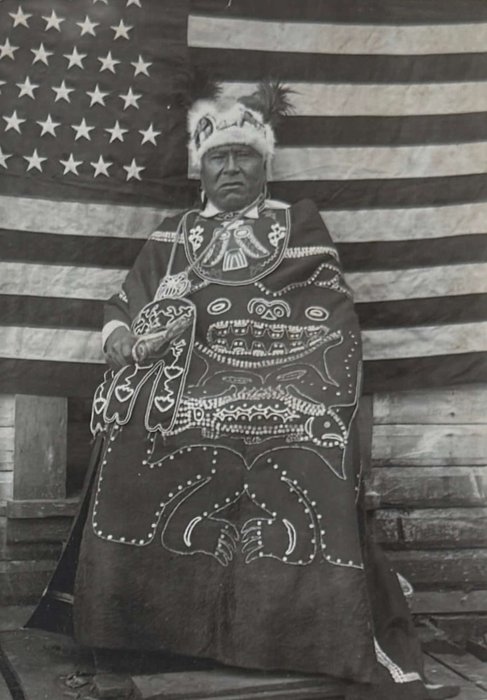
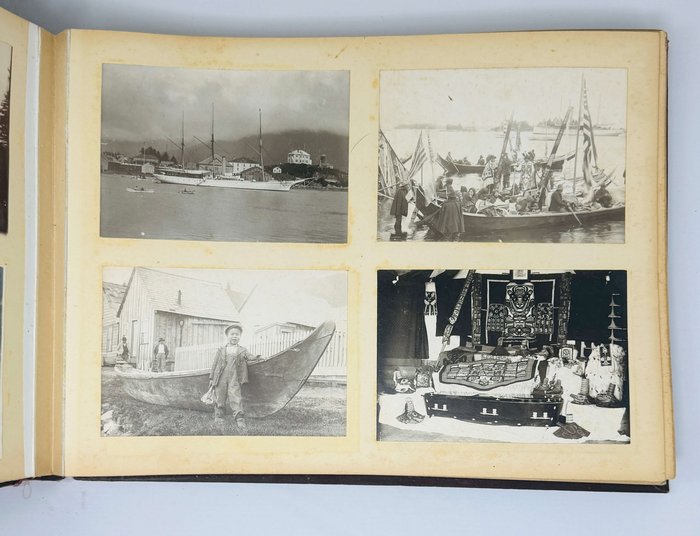
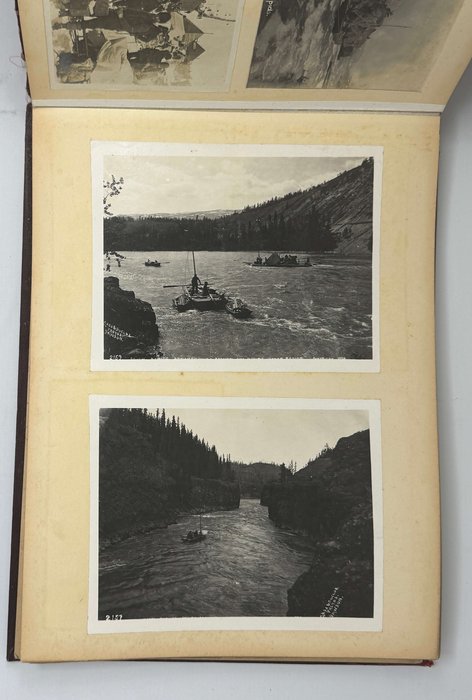
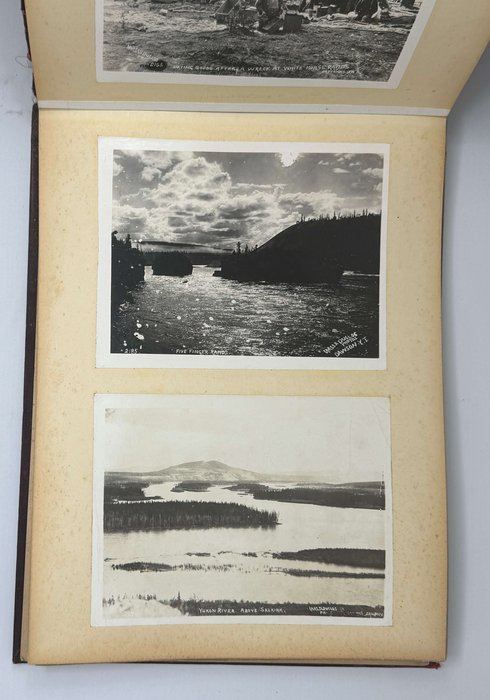
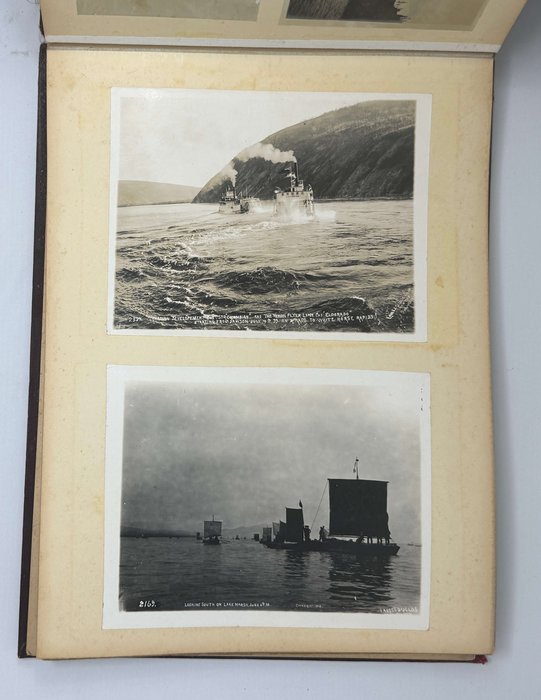
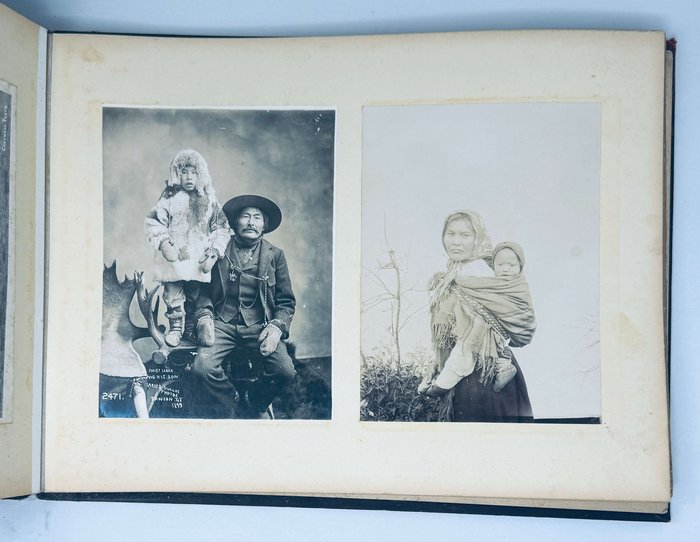
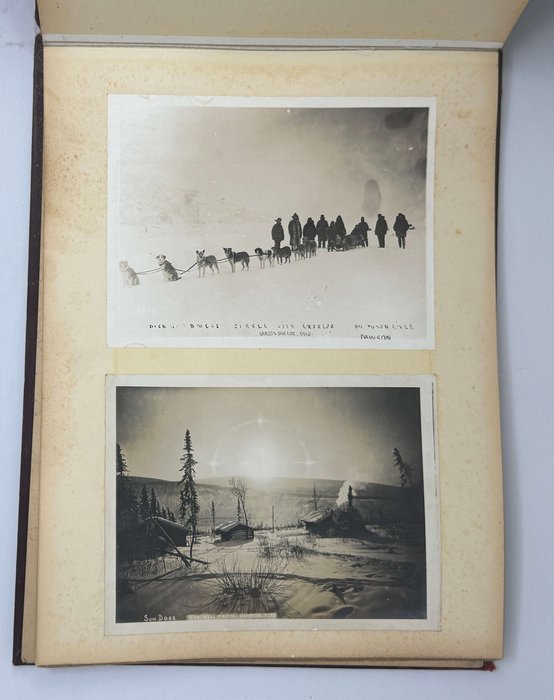
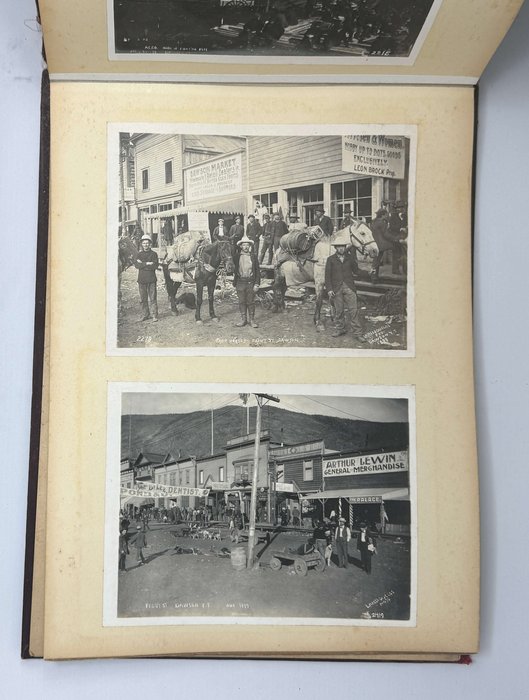
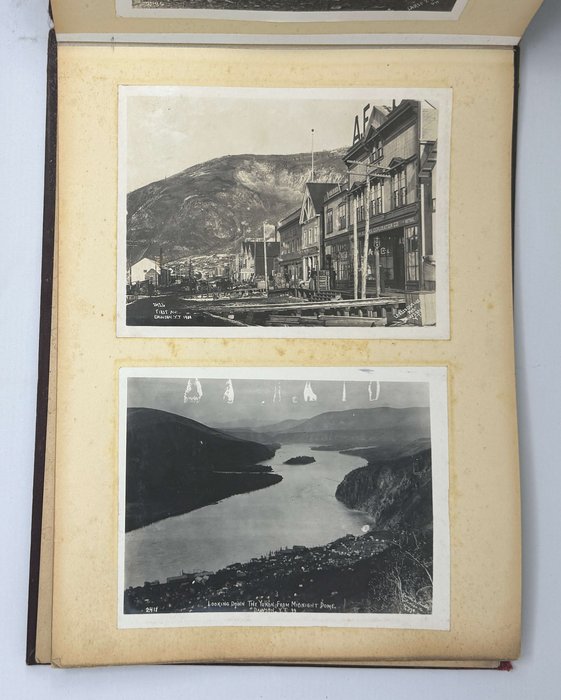
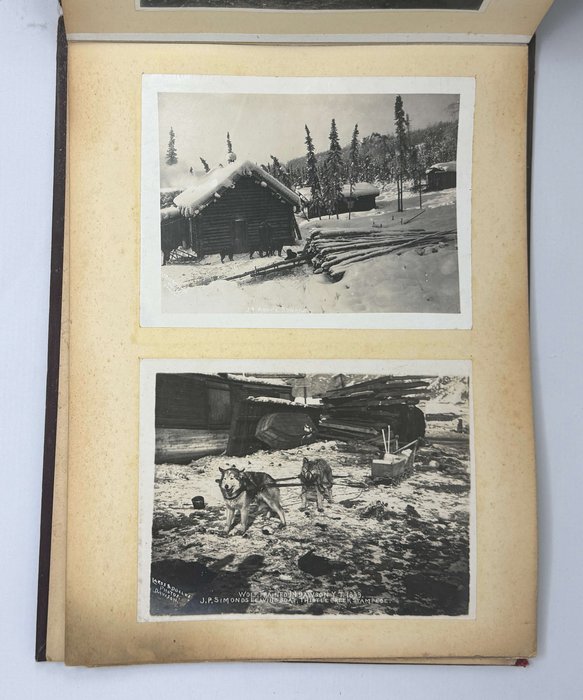
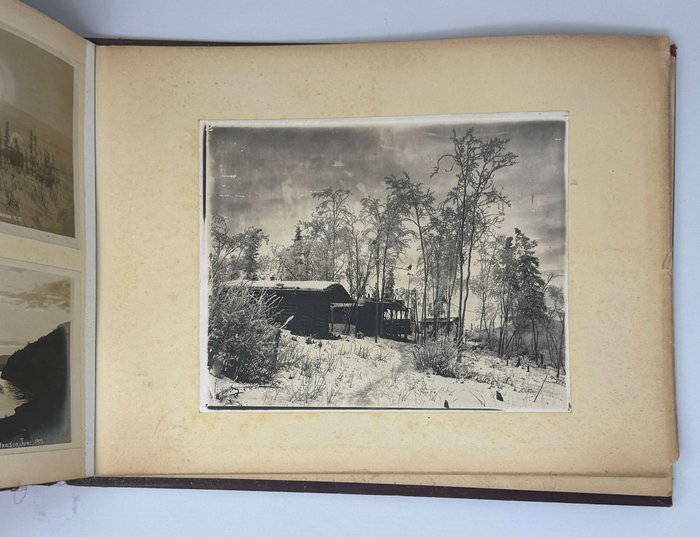
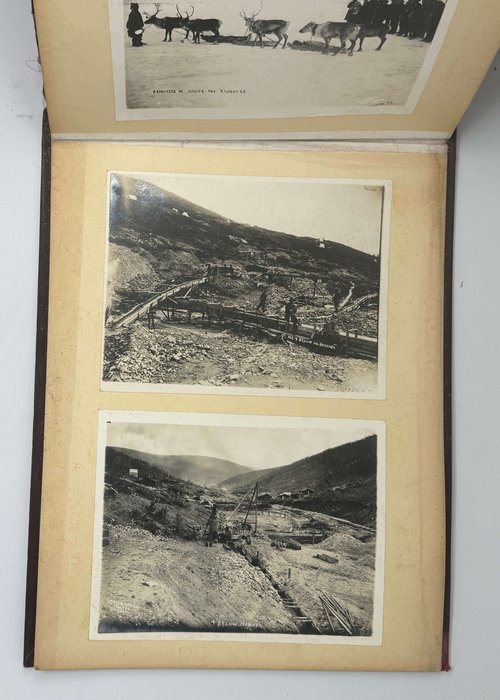
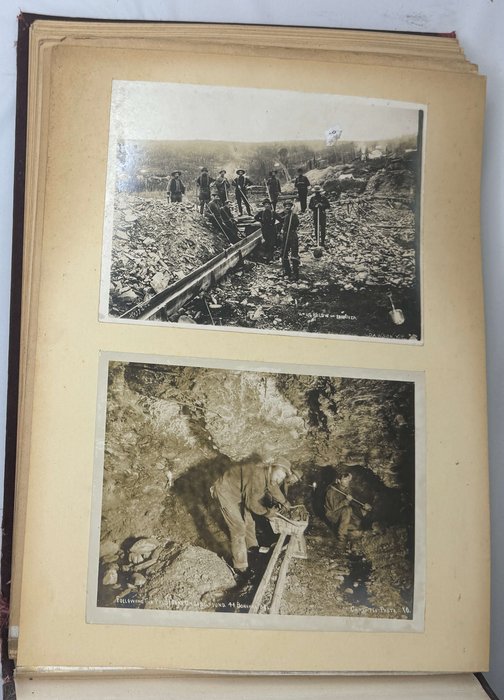
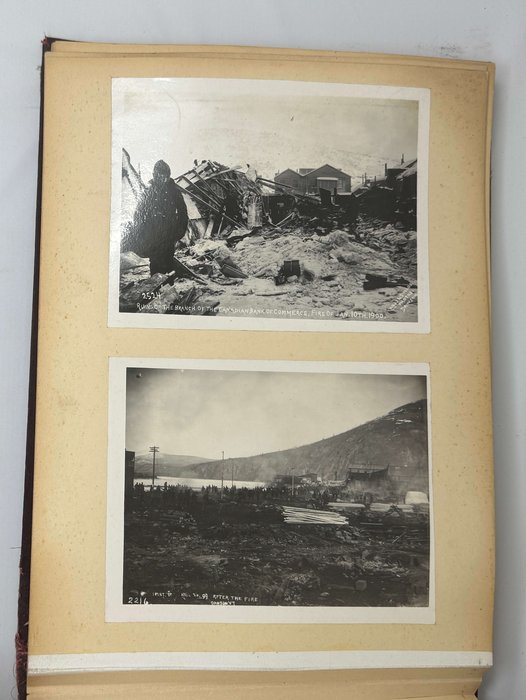
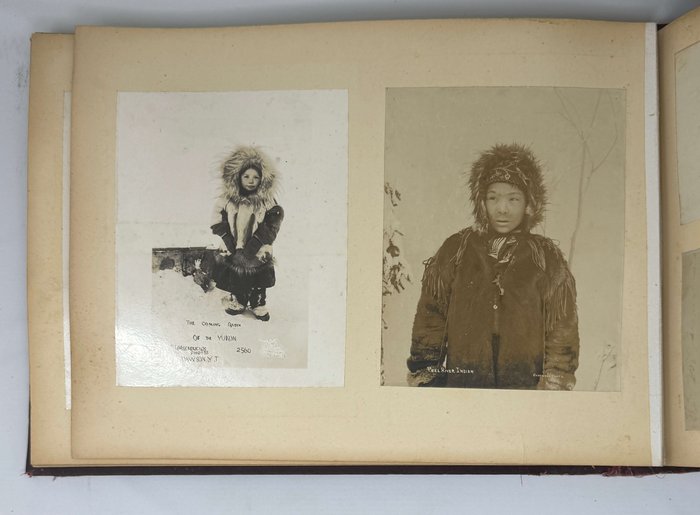
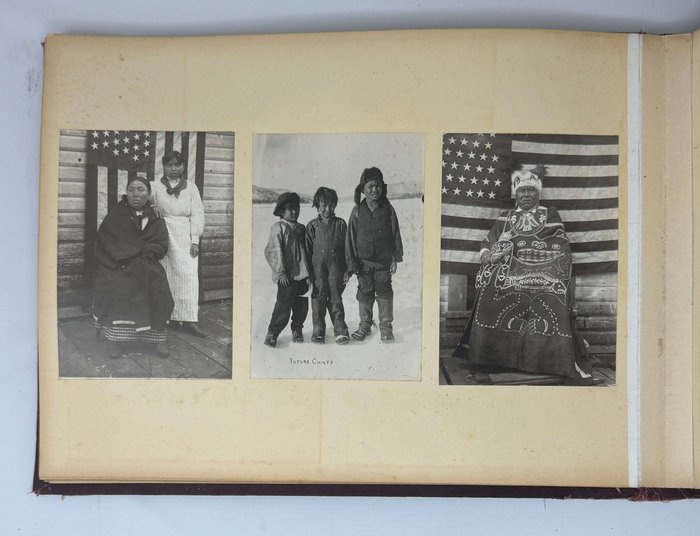
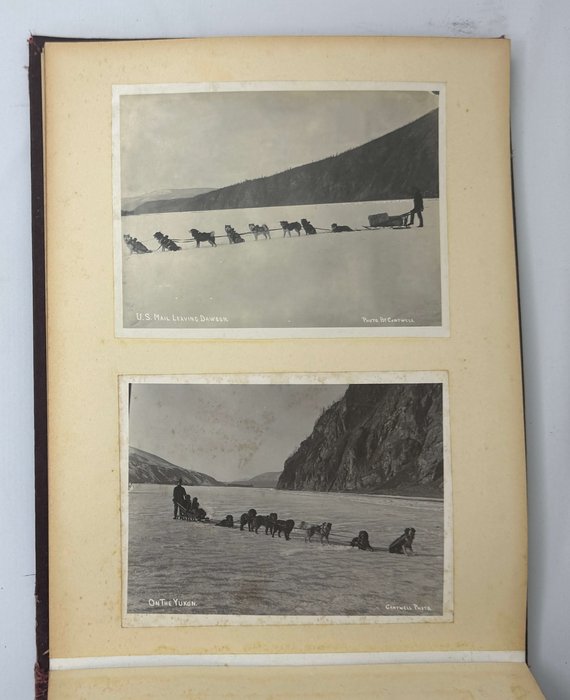
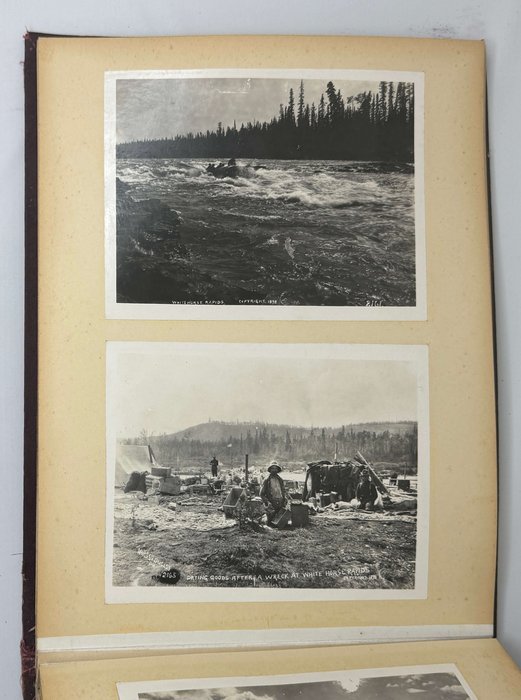
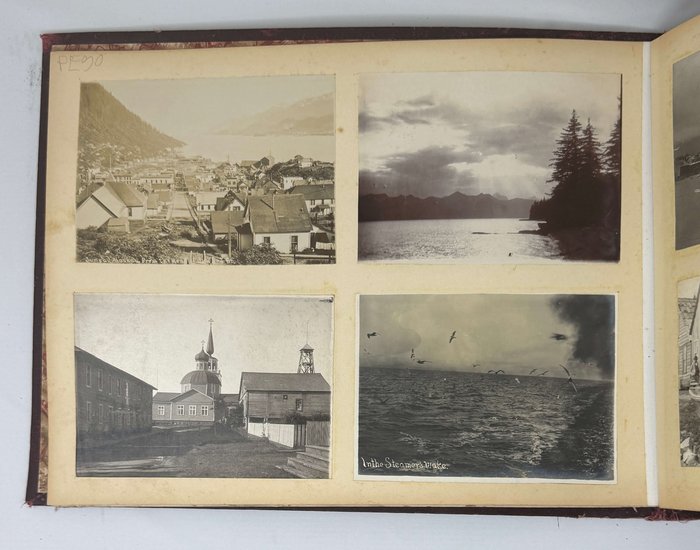
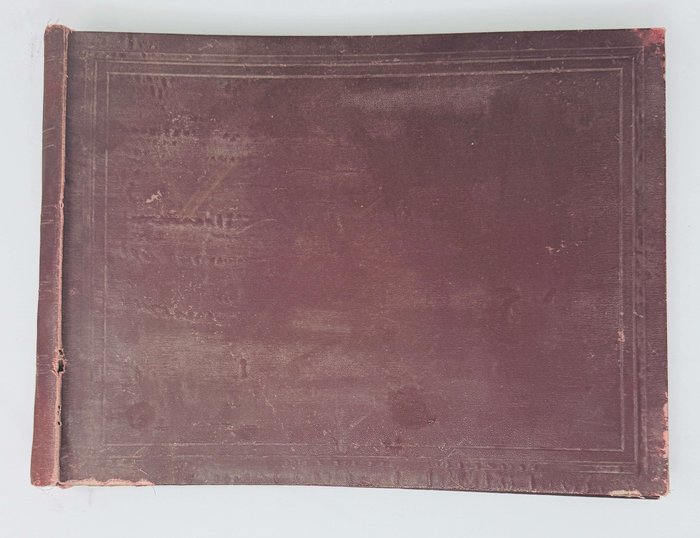
#PE90
Ca. 1898-1900s
Oblong Folio album (ca. 32x43 cm or 12 ½ x 17 in). 18 card stock leaves. With 87 original mounted gelatin silver photos, including four large images ca. 21,3x 26 cm (8 ½ x 10 in); the rest of the photos are from ca.15,5x21 cm (6 x 8 ¼ in) to ca.10,5x12 cm (4 ¼ x 4 ¾ in). Over sixty images with captions in negative, over forty images are also signed in negative. Period maroon full cloth album; faded gilt-tooled borders on both boards; marbled endpapers. Binding rubbed on extremities and weakened on hinges, spine with minor tears on top and bottom, block is shaky, several images slightly faded, but overall a very good album.
Historically significant album with early rare studio and amateur gelatin silver photos, documenting a prospector’s travel to the Klondike gold fields in 1898 (during the stampede) and gold mining and life in Dawson City in 1899 – early 1900s. The album opens with about twenty images of Northwest Pacific Coast, showing Juneau, St. Michael’s Cathedral in Sitka, harbours, glaciers, forested shores, &c. Very interesting are two photos of the famous steamship “Excelsior” (which became the first to bring gold from the Klondike to San Francisco in July 1897, starting the stampede), shown while beached on shore (apparently, in Alaska) with a damaged bow. There are also photos of native American canoes and indigenous people (decorated with U.S. flags), a scene with a deceased Alaskan chief with funerary offerings, &c.
Over a dozen images follow the prospector’s route to the Klondike over the Chilkoot Pass and down the Yukon River. A large photo by Henry Goetzman depicts a “Scene at Chilkoot Pass, Spring of 1898,” with a line of load carriers ascending the pass from the camp on the bottom (featuring signs of a “Restaurant” and a “Gasoline tramway”). The other images include scenes of “Descending from Chilkoot summit to Crater Lake” (by Larss & Duclos studio), “Lining a scow through Lindeman rapids,” and views “Burro pack train – Bennett” and “The Scales – 1898.” Seven larger photos by Larss & Duclos document a typical boat voyage down the Yukon River to Dawson City, which prospectors took after crossing the Chilkoot Pass: “Squaw rapids, between Miles Canyon and White Horse rapids, 1898,” boats navigating Miles Canyon and White Horse Rapids, a travelling party “Drying goods after a wreck at White Horse Rapids,” “Five Finger Rapids,” “Yukon River above Selkirk” and “Looking south on Lake Marsh, June 6th 98.”
The album also contains over a dozen interesting early views of Dawson City, including three large photos by Henry Goetzman, showing “Dawson, June 28, 1901,” “Shipment of gold dust, Sept. 20-99, $750,000,” and “Some Dawson dwellings.” A series of city views by Larss & Duclos show Front Street and First Avenue with a pack train, dogs, donkeys and numerous street and storefront signs, “Looking down the Yukon from Midnight Dome, Dawson Y.T. 99,” rare images of destruction after the fire on August 26, 1899 (“A.C. Co. mode of fighting fire, April 26th99, Dawson, Y. T.,” “Front St., April 26 99 after the fire, Dawson Y. T.,” “Looking over the ruins of Dawson from 2nd Ave, April 26th 99”) and “Ruins of the branch of the Canadian Bank of Commerce, fire of Jan. 10th 1900.”
Other photos by Larss & Duclos include views of “Canadian Development Co’s str. “Columbian” and the Yukon Flyer Line Co’s “Eldorado” starting from Dawson, July 4th 99 on a race to White Horse Rapids,” “Scow in the ice jam on Lake Marsh, June 7-99,” “The jam on Lake Marsh, June 7-99,” “Dick Gardner's Circle City Express on Yukon River,” “Laplanders arriving in Dawson Y.T., Jan. 8th 99,” “Reindeers en route for Klondyke [sic!],” portraits of “Chief Isaac and his son, 1899,” “the Coming Queen of the Yukon, Dawson Y.T.,” “Pioneers of Klondyke, Y. T.,” &c.
Four photos of gold mining include views of claims “No. 7 below on Bonanza” and “No. 45 below on Bonanza” (by Eric Hegg), “4 below Hunker” (by Larss & Duclos) and a scene with prospectors “Following the paystreak underground, 44 Bonanza Bel.” (by George Cantwell).
Other photos taken by George Cantwell show “U.S. mail leaving Dawson,” a dog sled “On the Yukon,” a native Alaskan with his sled dogs (“From the McKenzie River”), a sunny winter day in the Yukon (“Sun Dogs”), “Arrival of Peel River Indians in Dawson, Mar. 21 – 1901,” “Winter sun effect,” “Midnight sun, Dawson, June 1900,” portraits of “Dusky maidens of the forest,” “Peel River Indian,” “Chief Isaac” on a winter fishing, &c. Unsigned images depict “The Canoe of the Yukon,” “Lining a steamer through Five Fingers,” an abandoned wooden river steamer, a man with hunted moose, a native mother with child, a group of “Future chiefs,” an Alaskan chief posing in full regalia in front of the U.S. flag, a native couple in traditional outfit, “an Esquimaux mother,” a Royal Canadian Mounted policeman, &c.
Overall a captivating rare example of an album, documenting the stampede and early years of gold mining in Dawson City during the Klondike Gold Rush (1896-1899).
“H. J. Goetzman worked as a photographer in the Yukon from 1897 until 1904. He travelled to the Yukon via the Chilkoot Trail with his wife and Miss Edith Goetzman, a relative. Trained as a commercial photographer, Goetzman recorded the scenery, life and activity of the route to the gold fields through Alaska and Canada, Dyea, the Chilkoot Trail, White Pass Canyon, Bennett, Dawson, and the Klondike gold fields. He ran Goetzman's Photographic Studio in Dawson from 1898 to 1904. At the height of the gold rush he employed seven photographers. <…> Over the seven years he resided in Dawson, Goetzman moved his studio to several different locations, beginning in a tent <…>. In 1904, Goetzman sold his studio, negatives, and photographic supply house to J. Morte and H. Craig and moved to San Francisco. Many negatives were lost as the result of water damage from a fire in April 1907” (see more).
"Joseph E.N. Duclos (1863-1917) was born in Quebec but moved to Maine where he learned his photography skills. He and his wife Emily arrived in Dawson in 1898 via St. Michael and the Yukon River. Duclos worked as a miner on Lovett Gulch before joining Per Edward Larss in the photography firm of Larss and Duclos on April 1, 1899. Duclos specialized in studio portraits while Larss roamed the streets and the gold fields. They sold views of the Chilkoot Pass, Dawson and gold fields scenes taken in 1898 advertising "Thousands of negatives in stock". Larss and Duclos also sold film and supplies for amateurs. The firm was dissolved in 1904 when Larss left the Yukon but Duclos continued as a photographer in Dawson until 1912, when he sold his studio to E.O. Ellingsen. Duclos reported to Larss in 1905 that he was getting a fair share of the work although there was competition in the portrait business from Edward Adams and Mrs. Edith Goetzman. Joseph Duclos died of pneumonia after undergoing surgery in Alaska in 1917" (virtualmuseum.ca).
“George G. Cantwell, a native of Puyallup, Washington, came to Dawson from Juneau in 1898 where he was employed by E.A. Hegg. In 1899, he entered into a business partnership with Frederic N. Atwood. Their specialty was Alaskan views, outdoor portraiture, finishing and supplies for amateurs. The studio was located on 3rd Ave opposite Dr. Bourke's private hospital. In March of 1901 he took a series of underground views by the flashlight process. The partnership seems to have dissolved after June 1901. Cantwell stayed until September of that year when he returned to Puyallup, Washington” (see more).
“Eric A. Hegg was a Swedish-American photographer who portrayed the people in Skagway, Bennett and Dawson City during the Klondike Gold Rush from 1897 to 1901. Hegg himself participated in prospecting expeditions with his brother and fellow Swedes while documenting the daily life and hardships of the gold diggers” (Wikipedia).

